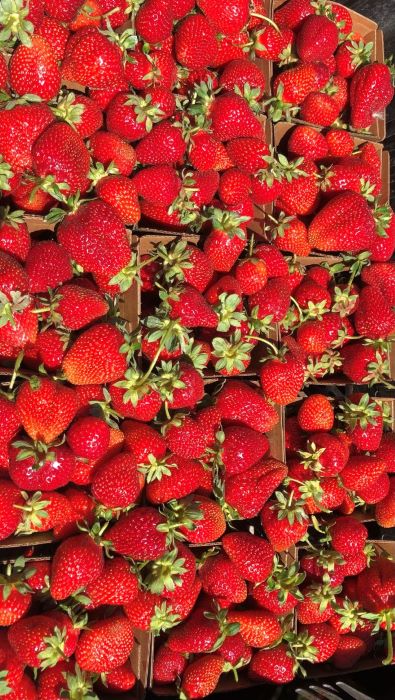Hidden Villa CSA
Week of September 11th, 2023
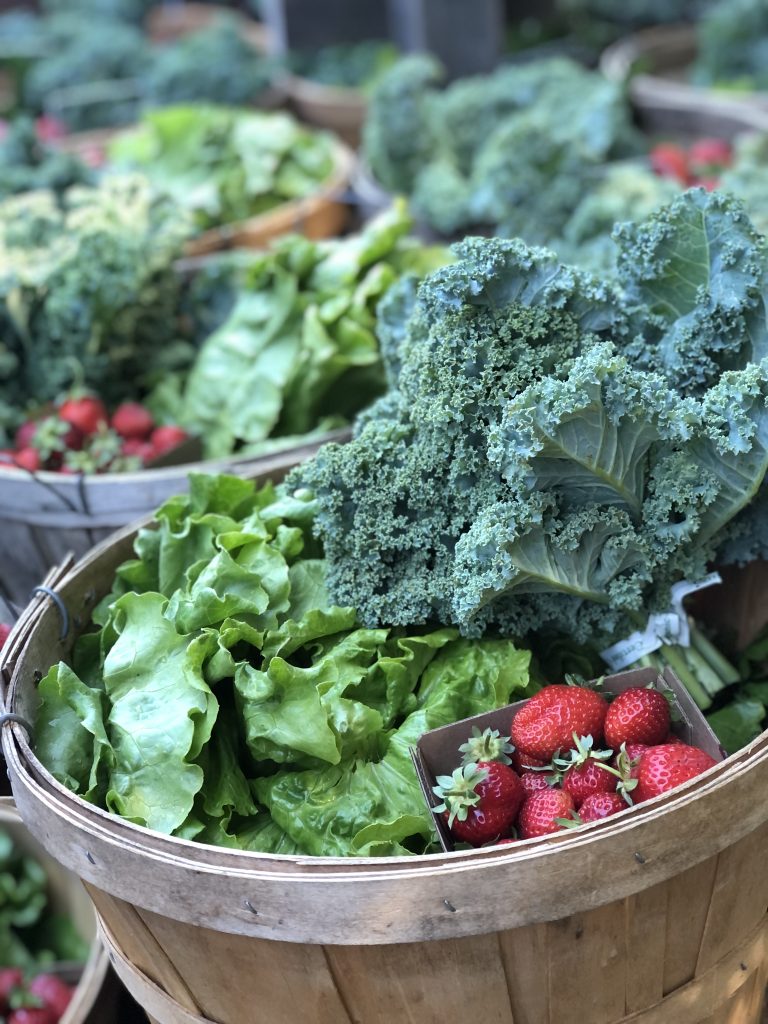
In these late days of summer when the seams of the farm are bursting with produce and flowers it can be hard to find a moment to sit down and write. I have the kernels of essays beginning to sprout in my head but little time to nurture them into being. In truth, this is not the season for sprouts, not yet. This is the time for harvest and abundance. In that spirit, I offer you a poem this week. Fully formed by another hand and heart for your, and my, enjoyment.
How to Stuff a Pepper
Now, said the cook, I will teach you
how to stuff a pepper with rice.
Take your pepper green, and gently,
for peppers are shy. No matter which side
you approach, it’s always the backside.
Perched on green buttocks, the pepper sleeps.
In its silk tights, it dreams
of somersaults and parsley,
of the days when the sexes were one.
Slash open the sleeve
as if you were cutting a paper lantern,
and enter a moon, spilled like a melon,
a fever of pearls,
a conversation of glaciers.
It is a temple built to the worship
of morning light.
I have sat under the great globe
of seeds on the roof of that chamber,
too dazzled to gather the taste I came for.
I have taken the pepper in hand,
smooth and blind, a runt in the rich
evolution of roses and ferns.
You say I have not yet taught you
to stuff a pepper?
Cooking takes time.
Next time we’ll consider the rice.
Bountifully yours,
Lanette
CSA 30th Anniversary Celebration and Tomato Tasting Festival – Friday, September 29th
In the Basket
Strawberries– Sweet as ever and ready for the eating. They don’t last long, I imagine you’ve figured that out by now. We harvest them when their at their peak of ripeness and ready to be enjoyed.
Sweet peppers– There are both ‘Carmen’ and ‘Gypsy’ peppers in the shares this week. Both are sweet, not spicy at all. Just a few this week, they come on slowly at first followed by an avalanche. Lots more to come. Might I suggest stuffing them 🙂
Tomatoes– This is a good tomato year! It bodes well for our upcoming tasting event. So many, in a rainbow of colors. I hope you have recipies at the ready. If not, simply slice, sprinkle with salt and enjoy. Honestly that might be the best way.
Cucumbers– Jason has been making a lot of delicious and refreshing cucumber salads lately. Some with a yogurt base and tossed with sliced olives, others with chunks of sweet apples and onions. So good!
Parsley– Perhaps one of the most underrated of fresh herbs. Pairs beautifully with potatoes, seafood and pasta, adding such a refreshing flavor.
Kale– I know there are a lot of haters out there and I get it. But if you follow the KLT recipe below I guarantee you’ll have a new appreciation for this ugly step-sister of the brassica family.
Lettuce– Growing lettuce in the summer here is a challenge, between the heat and the ground squirrels we have to fight for each head. So we’re very pleased to be able to bring you this late summer harvest.
Apple– An heirloom tree that’s been on the property for so long no one remembers what variety it is. We love its sweet, crispness.
Jason’s KLT
You’ve all heard of a BLT no doubt. Here is Jason’s vegetarian take on the sandwich classic using kale. I know what you’re thinking, kale for bacon?! Please try to reserve judgment until you’ve tried it. It’s so much better than you’re imagining, trust me!
- One bunch of kale
- Olive oil
- 2 cloves garlic
- ½ t dried oregano
- 2 T soy sauce
- Dash of red pepper
- Two large tomatoes thickly sliced
- 14 full leaves of lettuce washed
- 14 slices of sourdough bread
- Mayonnaise
Preheat oven to 400°F. Wash kale and use a chef’s knife to slice out the center rib of each leaf. Chop the remaining kale leaves into medium sized chunks. In a large bowl toss the kale in 2 T olive oil Thoroughly coat the leaves, mashing them about to soften them. Spread thinly onto two oven sheets and roast them for 8 minutes. Meanwhile prepare the basting sauce by pureeing garlic, soy sauce, red pepper, oregano, and 2 T more olive oil. For additional spice and flavor roast an Anaheim pepper and puree it in the basting sauce with about 10 leaves of basil. Remove the kale from the oven and put it all in the large bowl. Pour the basting sauce over it and toss to coat the leaves thoroughly. Spread the leaves onto one of the trays and roast for another 8 minutes until crispy and “fully baconized.” Toast the bread and prepare the tomatoes and lettuce. Spread a thin layer of mayo on both sides of the bread. On one side of the bread layer the cooked kale leaves about ¼ inch thick, on the other side put slices of tomato and two leaves of lettuce. Carefully match the sides of the sandwich together, slice and serve. Makes 7 sandwiches.
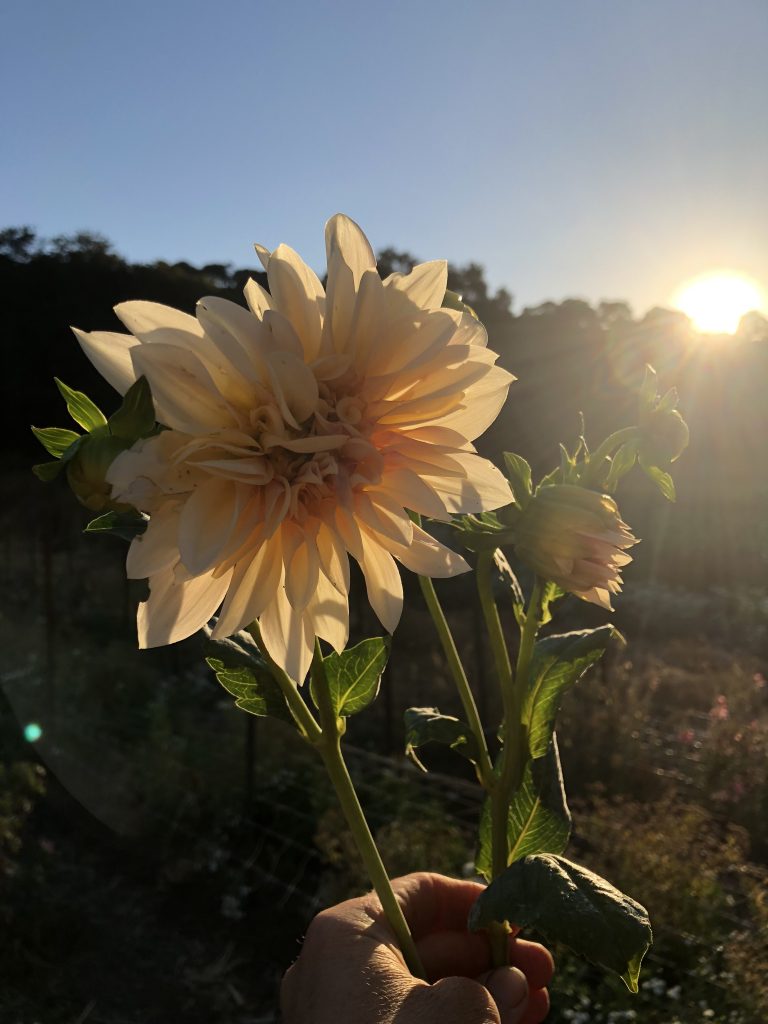
Featured Flower
Dahlia pinnata
‘Cafe au lait’
Dahlias come in more varieties of colors, shapes, and sizes than any other flower I can think of. It’s astounding really. As if that wasn’t enough to endear them to you, they produce tubers you can divide at the end of the season so that where you started out with one plant you now have two. Incredibly generous plant! This beauty is ‘Cafe au Lait’, a classic wedding flower dahlia. She’s a bit finicky, with shorter stems than I’d like and blooms that vary in color from off-white to pink streaks, but she’s worth the trouble and unpredictability.- Lanette
Hidden Villa CSA
Week of September 4th, 2023
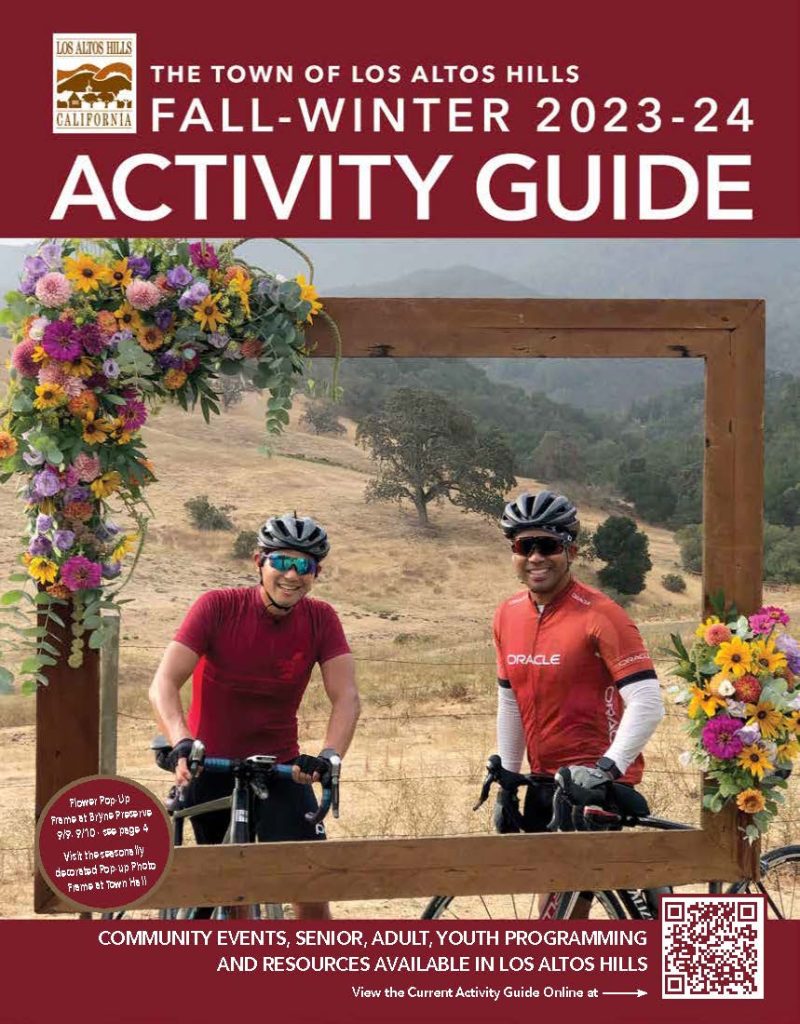
We spend a lot of time on our hands and knees in the strawberry patch moving up and down the rows, scrutinizing and brushing the plants around while we harvest the berries. As usual this year we planted our berries in November last year in an area of the field where we had had deep wood chips decomposing for several years. During this decomposition Virginia and Austen had ranged many pigs through the space. You may have heard from us before about this strategy of housing the growing pigs on the piles of wood chips particularly during the muddy winter months so that they are more accessible for feeding. Many different sets of pigs had roamed over and through these wood chips, rooting and pooping and generally assisting the healthy decomposition of the chips, as well as soil building and carbon sequestration.
This year in the strawberry patch we have been noticing an unprecedented amount of desirable weeds or volunteer plants. Among the strawberries there are a dozen young pomegranate bushes growing along with 20 or so raspberry canes, some Big Leaf Maple trees, Acacia trees, and hundreds of young melon plants. We have seen a little bit of this before, what we call a pig’s butt melon. Pigs are fed a bunch of overripe melons, they pass the seeds in a nutrient rich package and it germinates the following year to produce a viable fruit. The most notable pig butt melon I ever saw was an enormous watermelon vine that grew in the middle of steinmann’s pasture mid-ranch 10 years ago never getting watered and producing a 15 pound melon out in the dry, dusty ground. It was delicious though I don’t think I bragged about its origins with anybody that I shared it with. This phenomenon easily explains all of the melons growing among our strawberries but the other volunteers are really puzzling me.
Firstly, I don’t think anyone fed the pigs pomegranates. Second, I have never seen pomegranates self seed under the mature producing bushes that we already have and that seems like the most likely place. I looked it up and there are recommendations about how to start pomegranate seeds and I guess I have never intentionally tried but it seems like these small plants are kind of miraculous. More so for the raspberries. Starting raspberries from seed is supposed to be really hard and one of the main reasons why most growers propagate cane berries like raspberries from pieces of the canes. Again I don’t think anybody fed the pigs raspberries. We have failed in growing them here so many times that I have given up and we don’t even have any! Mystery! But then what about the maple and acacia trees? Neither of those species produce any kind of fruit or edible part to their seed.
I’m starting to wonder if the marriage of deep, long term decomposing wood chips plus pig manure and aerating disturbance is creating some kind of optimal seed nursery? It is a confluence of many potentially beneficial factors including of course the regular irrigation that the strawberries receive. It remains a pretty big head scratcher but like so many make hay situations that Lanette and I find ourselves in, as soon as the weather cools we intend to dig up all these young perennials. We’ll see how they over winter in the greenhouse and transplant all the successes into our fields next year. Could be a really cool origin story.
-Jason
Please come and photograph yourself and your family at Hidden Villa’s floral frame this weekend. Lanette will be assembling and designing the flowers for the frame starting Friday morning and it will be up all weekend until Sunday afternoon near Westwind Barn. It is a beautiful frame with a beautiful backdrop for your photos!
CSA events summer 2023
CSA movie night – Friday July 21st
Floral design course for flower share members – Saturday, August 12th
Cob Oven Pizza Party – Friday, September 8th
CSA 30th Anniversary Celebration and Tomato Tasting Festival – Friday, September 29th
In the Basket
Strawberries: The patch is still doing great!
Walla Walla onions: For all of your end of summer onion needs
Watermelon: I bet you ate the first one fresh so maybe this second one is good for agua fresca. After all this is the last of the first patch and there is a whole other patch of them that should be ripening in two weeks!
Tomatoes: A mix of slicer tomatoes for sandwiches, salads, sauces, you name it.
Basil: By this time of summer basil has reached it’s maximum aromatic qualities. The highest use is fresh leaves on a freshly cooked pizza, so savory.
Eggplant: Asian and Italian varieties for grilling, roasting, or frying. I made eggplant parmesan with panko breadcrumbs last week and it was awesome.
Anaheim peppers: So versatile because they are mildly hot. Use in salsas, roasted, sliced onto sandwiches, pickled, added to marinara sauces, on pizzas and of course the deconstructed chili relleno recipe from two weeks ago.
Cucumbers: Well, we usually plant three patches of cucumbers a year because the ground squirrels typically destroy one of them. For whatever reason they have spared the cukes so we have insane amounts of them because all three patches are now producing. I don’t know how much more I am capable of encouraging you to make pickles.
Watermelon Salad with Onions, Olives, and Feta
I first saw a salad like this about ten years ago and I was a doubter. Why go the savory direction with watermelon I said. Then I tried it. It is just one of those things you can’t explain-you just need to try it.
5 cups of watermelon chunks
1/4 cup very thinly sliced sweet onion
3 T balsamic vinegar
1/2 t salt
3 T olive oil
1/4 t freshly ground black pepper
1/2 cup of whole but pitted Kalamata olives
6 oz of crumbled feta cheese
Chill the watermelon until very cold. I like to prepare the watermelon by slicing it in half and then scooping balls from the melon half with a smallish spoon into a large measuring cup. When I have the five cups measured, I pick up a paring knife and transfer each ball to the salad bowl while de-seeding the chunks into the compost. Slice the onion and marinate it in a small bowl with vinegar, salt, olive oil and pepper. Prepare the olives and cheese. Combine all ingredients in the salad bowl and carefully and thoroughly mix them. You want to be sure the flavors mix well but that you don’t crush the watermelon. Pairs beautifully with focaccia.
Featured Flower
Pampas Plume Celosia
Celosia argentea plumosa
Celosia argentea plumosaCelosia is a feathered rainbow and a flower I look forward to all season. They add a unique texture to bouquets that no other bloom quite matches. This variety is tried and true, though there are many others. Its bright colors are a hallmark of the family, Amaranthaceae. They are cousins to other colorful crops like beets, chard and you guessed it, amaranth!- Lanette
Hidden Villa CSA
Week of August 28th, 2023
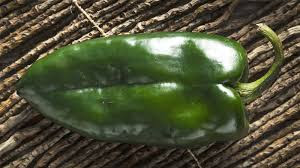
This week I’m pulling a newsletter out of the archives, as it is coincidentally my good fortune every year to narrate our newsletters on the first week of the mighty Poblano Pepper Harvest! Please enjoy this tribute to my favorite dish of all time:
The seasonal stars are aligned in the months of August and September- the fruits and foliage necessary to make my favorite dish, “Chile en Nogada”, are all ripening and thriving simultaneously. I’ve been waiting all year for the ability to harvest the necessary ingredients for this stuffed Poblano opera-in-your-mouth. These charred peppers, along with fire roasted tomatoes, apples, pears, pomegranates, parsley, garlic and onions make up a meal that comforts the heart of a farmer who eats with the season.
In this line of work, you come to decipher the months by the vegetables and fruits that make their bulk debut in the fields. September and August are special months- everyone has a leading role. Tomatoes are at their peak and almost every round we’ve planted are ripening at once. The kernels of sweet corn are plump and best eaten right off the stalk. Stone fruit makes way for watermelons and honeylopes, strawberries trudge on, and apples and pears hang heavy on their dainty branches. The onions cure in storage, the winter squash builds color beneath sail-like leaves, and the sweet peppers droop from the plants en masse. This is the time when 90% of our meals are harvested, raised, and sown by our very hands. It’s only grain and dairy that we purchase from the store as our herbs and chickens and staple crops continue in an unwavering production. Our lunches consist of panzanella or caprese, pesto pastas, grilled corn, melon smoothies, and salads that could paint the color wheel. To track the progression of my year like this is the only way for me to make sense of how we fit into the complex structure of nature. By growing and tending our food, we wait for its arrival with a mouth-watering expectancy that the average consumer is not organically privy to. But to me, this seems like the most natural culture to conform to- processing the passing of time through our very life-blood in food. When the field is abundant in the summer months, we are privy to the enjoyment of these abundant crops- light and acidic flavors highlight our palette. Soon, as the frost takes the life out of this supply and the cold lures us inside, we turn to our carb-heavy storage crops of sweet potatoes, winter squash, and root vegetables to keep us nourished as we hibernate and prepare our seeds for the next season. In the spring, we rejoice over the new growth of mustard greens, callaloo, peppery arugula, and green onions. There is always something to look forward to. My partner, who initially stole my heart with his interpretation of Chile en Nogada, recently told me that what he loves most about me is the obvious experience I am having when I eat food. When it’s good, I’m doing a little dance as I chew and you can see me savor every bite. When it’s bitter or tart, you’ll witness my whole body wiggle and my eyes open wide. I feel my food with every fork or finger full, and in these late Summer Months I am usually doing a lot of dancing.
Now, I know I couldn’t brag about this phenomenal meal I wait all year for without providing you the recipe. Lucky for me, my week of writing the newsletter is also one in which we provide you with the poblanos, tomatoes, apples and parsley (Hopefully you still have an onion left from the last few weeks!), so please take a look at the instructions below. While I’m urging you to enjoy my favorite dish, I also implore you to navigate the shifting of the seasons by identifying foods or recipes that signify where you have laid down roots, what nature is telling you to eat, and to take the time to relish in the bounty of the moment.
-Katie
CSA events summer 2023
CSA movie night – Friday July 21st
Floral design course for flower share members – Saturday, August 12th
Cob Oven Pizza Party – Friday, September 8th
CSA 30th Anniversary Celebration and Tomato Tasting Festival – Friday, September 29th
In the Basket
Poblano Peppers: The charring and skinning of these peppers that is described in the recipe below is essential to most poblano dishes!
Tomatoes: They’re just going to keep coming folks! Tomato Jam is my favorite way to preserve them
Apples: Another mix batch of all of our varieties in production around the farm currently! Watermelon: Blend up into agua fresca to pair with the recipe!
Parsley: Not simply a garnish! An essential Flavor Component.
Cucumbers: You know what to do. Pickle them quickly!
Summer Squash: This round is coming to an end, enjoy them while they last! Strawberries: Production is ramping up again! Pair with parsley for a refreshing cocktail.
Chile en Nogada
Ingredients:
The Picadillo (filling):
● 4-5 poblano peppers
● 1 lb ground turkey, chicken, or pork
● 1 cup (4-5) fire roasted and crushed tomatoes ● 1 medium onion, chopped
● 3 cloves garlic, chopped
● 1 apple, peeled and diced
● 1 pear, peeled and diced
● 1/2 cup golden raisins
● 2 Tbsp slivered almonds
● 1 Tbsp butter
● 2 tsp cinnamon
● 1/2 tsp allspice or ground cloves
● Salt & pepper to taste
Walnut Sauce:
● 1 heaping cup walnuts
● 2 cups milk
● 1/3 lb queso fresco
● 1 1/2 cups sour cream or yogurt
● 1 1/2 Tbsp sugar
● 1/2 tsp cinnamon
Garnish:
● Pomegranate seeds and parsley\
Directions:
1. (The night before): Soak the walnuts in the milk overnight in your fridge for your cream sauce!
2. Charr the poblano peppers over an open flame on your stove or under the broiler until blackened. Once cooled, scrape off the charred outside to reveal a softened pepper. Keep the stem intact while cutting a slit down the middle of the pepper. Remove seeds and veins to the best of your ability.
3. (The Picadillo): Roast your tomatoes like you did the peppers, over an open flame or under the broiler, and then crush them with a fork into a bowl. Cook your meat in oil and salt for about 5-10 minutes, or until mostly cooked through. Remove from the pan and set aside on a plate. Add to your pan the chopped onions, a little more oil, and then your spices – cinnamon, allspice or cloves, black pepper, and salt. Cook for 2 minutes, add chopped garlic, and cook for 2 more. Melt the butter in the pan along with the partially cooked meat. Add the fire roasted and crushed tomatoes, golden raisins, apples, and pears. Adjust spices to your desired taste (but go easy on the cloves). Cook everything together for 5 more minutes.
4. Make the sauce! Drain the milk out of the walnuts (while the milk is not a part of the final sauce, it’s great to save for milkshakes!). Place the walnuts into a food processor or blender. Add the queso, sour cream or yogurt, sugar, and cinnamon. Blend fully.
5. Stuff your peppers with the Picadillo. Coat them in your walnut sauce. Garnish with pomegranate seeds & parsley (these are vital components!). Serve immediately and melt over the deliciousness. (Picadillo & sauce can also be made the night prior for an easy assembly the next day).
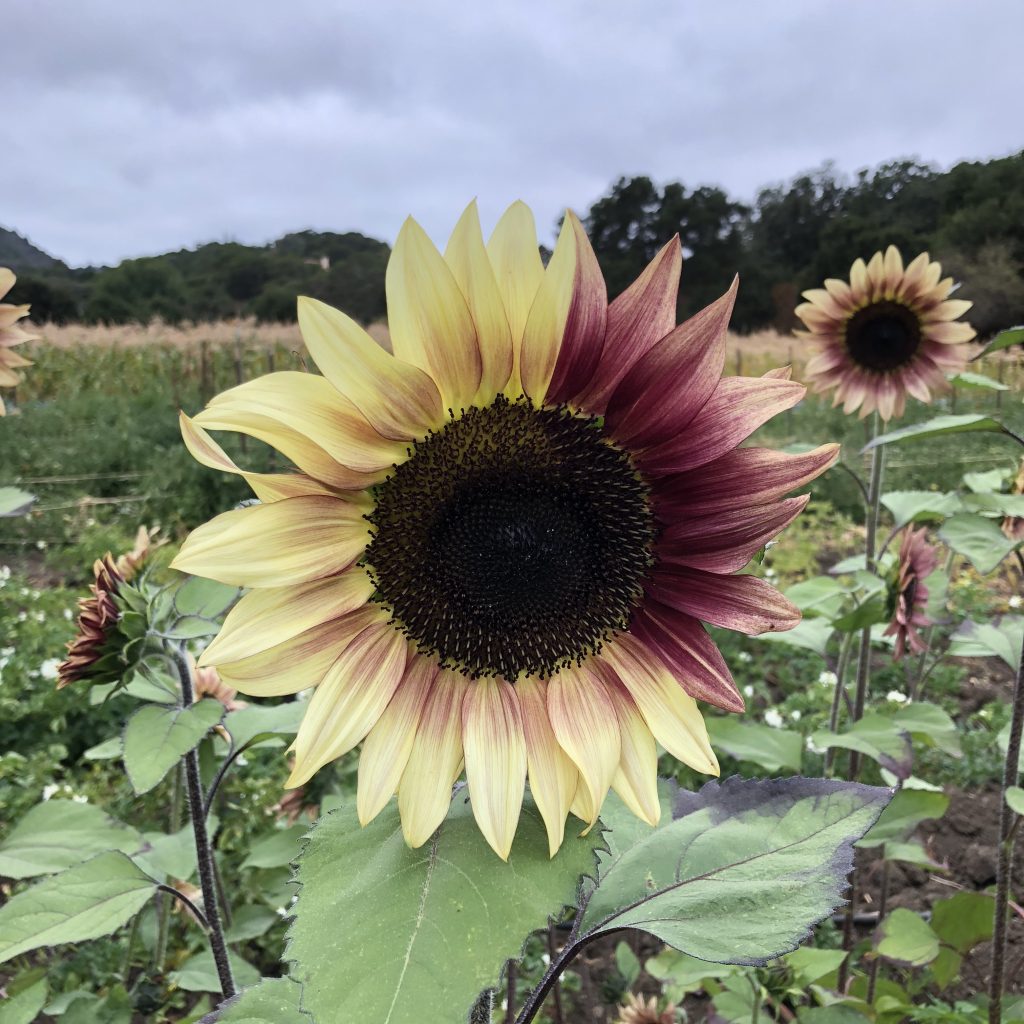
Featured Flower
Strawberry Blonde Sunflower
Helianthus Annuus
The subtle autumnal colors of these sunflowers feels perfectly in tune with the feeling of fall I’ve been beginning to sense in the air these days. We’re still experiencing the summer heat but the mornings are noticeably cooler and darker, the first hints of the coming change in seasons. I hope you appreciate their subdued loveliness as much as I do. – Lanette
Hidden Villa CSA
Week of August 21st, 2023
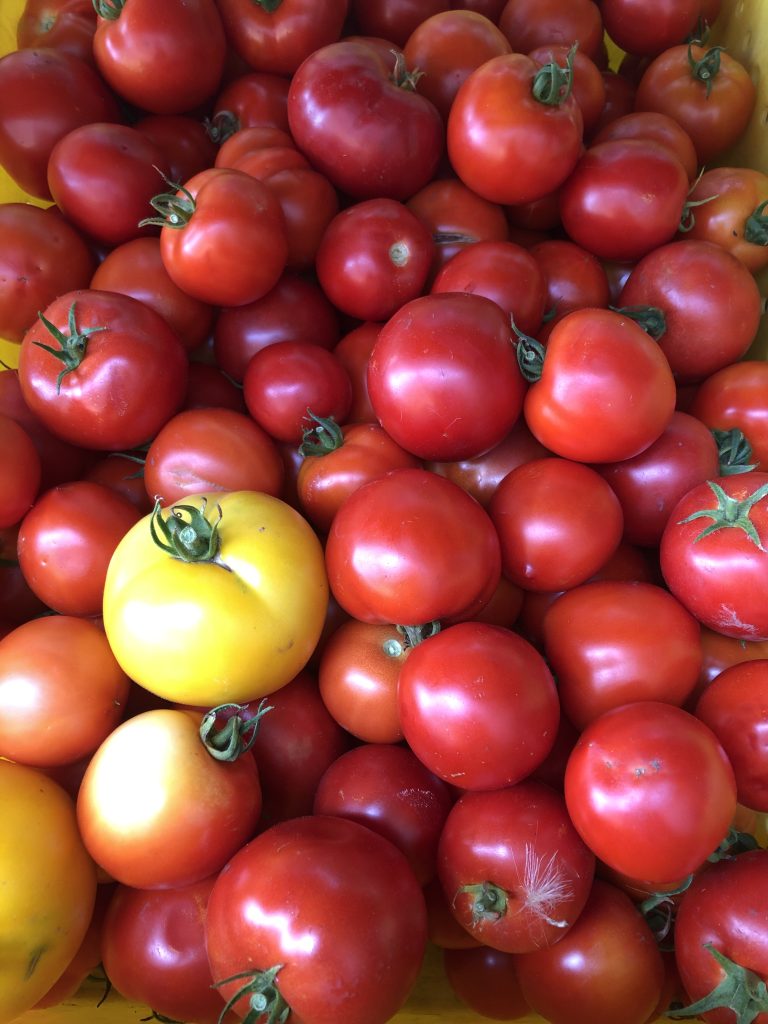
My stepson, Jason’s son, leaves for college this week. It’s cliche to say, but I can hardly believe it. It seems like only yesterday we were teaching him to ride his bike and tie his shoes. Time is a funny thing and there’s nothing like a big milestone like this one to make you look at it slant. He has crossed all the expected thresholds to be at this door. He’s graduated high school, turned 18, applied and been accepted, packed his bags. I know he’s ready and yet I can’t help but worry and wonder, how will this work?
This feeling is familiar, or at least a shade of it is. Each winter when we start out seeds in the greenhouse I feel a twinge not not unlike this. The seeds are so tiny and as Mary Oliver would say, so thoroughly asleep. Snapdragon seeds, for example, are only slightly larger than the period at the end of this sentence. Just tiny specks of dust really. I sprinkle them onto the cold flats of potting medium, sometimes scraping off January’s frost before beginning the process, my fingers numb. Then I tuck them into our germination chamber, our attempt to artificially simulate an environment they’d actually want to grow in. It all feels rather precarious. Nothing about the process feels secure or solid. Indeed it’s not. There are plenty of times when despite my best efforts to measure and mix, tend and nurture, only a few scraggly sprouts emerge. But I trust in the process. I know from years of experience this is what you do. If it fails the first round, we try again. Maybe tweaking the timing or the composition of the mix a bit. Most of the time it works. That’s my goal, get it to work most of the time. It might seem like a low bar to set, like a pass or fail course, but there are just so many factors outside of my control. I like to think of regenerative farming as like having very loose reins on nature. We’re trying to guide growth here, and discourage growth there but our will is just one among many. The bacteria, fungi, weeds, pests and predators all tug at the reins hoping to steer things in their favor. It’s hubris to think we can ever have more than a little control. A fact that I’ve learned is true both for farming and for parenting. We have tried to guide our son, to nurture him and prepare him as best we can. In so many ways he has succeeded and thrived. He is kind and curious, an incredible artist and a determined student. But there are also paths we’ve directed him down only to watch him wander off course, following his own guide. Despite my hesitations and worries that he might not be ready, too tiny and fragile a seed to sprout on his own, it’s time for him to go off and try. I’ll try to trust this process too.
-Lanette
CSA events summer 2023
CSA movie night – Friday July 21st
Floral design course for flower share members – Saturday, August 12th
Cob Oven Pizza Party – Friday, September 8th
CSA 30th Anniversary Celebration and Tomato Tasting Festival – Friday, September 29th
In the Basket
Apples- A mix this week of pink pearl, gravenstein and an unknown heirloom. All good fresh eating apples but the pink ones are actually pink inside!
Basil- Big bunches this week as this summer crop really hits its stride. It’s a great day to make pesto.
Anaheim Peppers– Medium spicy and absolutely perfect for the deconstructed chili relleno recipe included this week.
Eggplant- Just a few to get you started, hopefully lots more to follow provided we can keep the squirrels at bay. They are huge eggplant fans, who knew?!
Sweet corn– Smaller ears this week but just as sweet. I love to grill it in its husk and serve it with salted butter.
Tomatoes- The first of the season, not counting the Sungolds, who are really in a category of their own. It’s the usual cast of characters first to the stage; Early Girl, Chef’s Choice and Lemon Boy.
Strawberries- The plants are cranking out berries now, I think they like the cooler, wetter weather. No instruction necessary, just pop in your mouth and enjoy!
Cucumbers- More for your salads and pickles.
Walla Walla onions– Keep cooking. Together with the peppers and tomatoes you’ve got all you need for this week’s recipe.
Pan Simmered Chile Rellenos
5-6 Anaheim peppers coarsely chopped (seeds and all)
Olive oil
Salt to taste
1 large onion finely chopped
5 medium tomatoes coarsely chopped
6 oz grated cheddar cheese
Heat a large skillet over high heat and add 3 T olive oil and the peppers. Stir fry the peppers until slightly softened-8 minutes. Add onion and salt to taste and continue stir frying another 8 minutes. Add tomatoes, salt to taste and continue stir frying another 20 minutes until peppers are fully softened, onions are caramelized golden brown and the tomatoes are stewed and thickened. Grate cheese on top. Goes well with beans and rice.
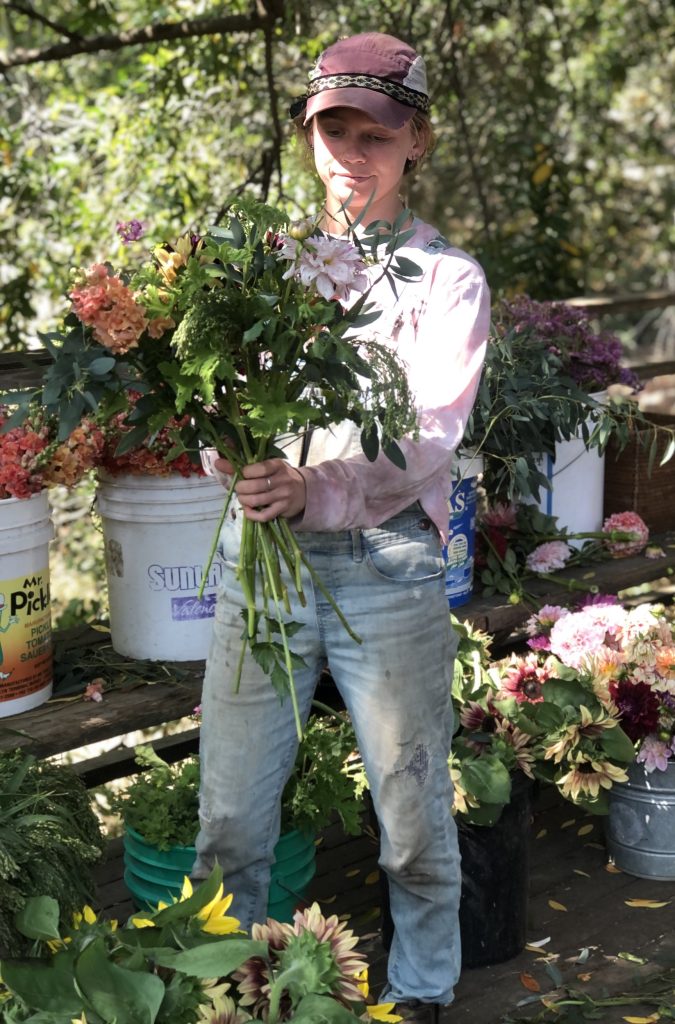
Featured Flower
Huddleston superbum
This week’s featured flower is a most unique variety, a lovely and hardy blossom endemic to this area, Huddleston superbum, otherwise known as Katie Huddleston 😉 I wanted to feature Katie here because this week she’s generously stepped up to do the flower arranging for all the CSA bouquets as I nurse an arm injury, but also because she’s just such a farm all-star and always willing to step in to do what’s needed and help out. Thanks Katie!
-Lanette
Hidden Villa CSA
Week of August 7th, 2023

Dear Friend,
It has been a lot of years since our first efforts in planting fruit trees at Hidden Villa. I am personally fond of the Chinese proverb: the best time to plant a tree was twenty years ago, the second best time is now. I remember putting in over 100 trees of so many different varieties in 2007. The hope and promise that each of them held. A season like this one with our unprecedented cherries and figs is part of the long awaited result from all that initial work and the years of maintaining it. It definitely feels a little ridiculous to recognize that the biggest difference that allows for these successes with fruit are not in the process of growing them, but in the process of successfully protecting them from all the critters who want to eat them. The hassle and cost of putting up giant nets over everything wasn’t part of the aspirational dreams I had when first planting the trees here.
Bare root fruit trees are astronauts. Most fruit stock comes this way when you buy it-a hearty rootstock that has had the desirable fruiting genetics grafted onto it, cut and stuck together and then that smallish, mutant tree has been grown for a season or two to allow it to establish some decent roots and trunk (like up to one inch diameter). Those trees are dug up in the winter, the roots are pared down, cleaned off, the tops are usually chopped short, they are packed in a bag, packed in a box and shipped somewhere else in the country to be planted into a completely different soil ecosystem. Through this lens it is no surprise that lots of these bare root trees develop problems like fungal disease, viral stunting, or fall prey to rodent incursions (even despite the protective metal cages we provide them with.) In years of growing and maintaining trees I have finally absorbed the words and meaning that Lanette’s orchard teacher at UC Santa Cruz, Orin Martin imparted years ago: “pruning fruit trees is a really long conversation with a tree.” I believe that I have grown familiar and close enough to the trees I keep to recognize moods and phases that they go through. It really feels as open-ended as parenting. Sometimes I think that some individual trees are upset or grumpy or even something less effable like homesick. It is hard to know what can help out in these situations. Usually water and pruning are good. My parenting metaphor holds up for the water thing since our son does a mediocre job staying hydrated but I don’t know what the analogy is for pruning. Lanette had this postcard on our fridge a few years ago that said, thrive where you are planted which is a cool sentiment, but I deeply wonder sometimes if there might be some unique, difficult, or undesirable qualities to the soil that I plant some of our winter time bare root trees into? Maybe I am not able to amend or improve upon these things. That feels like a helpless parent.

Several years ago, Lanette and I were driving out to check out a camping site at Arroyo Seco near Soledad for the first time. As we drove the winding road rising out of the huge monocultured, row crop fields and climbed to the canyon edges, the whole feel of the area changed. We crested a hill and looked down upon a probably 10 acre vineyard planted on the flat, marginal soils above the canyon. Both of us noticed how beautiful it was that the grapes had been planted in their trellis formations but that gaps had been left to respect the enormous oak trees with their sprawling branch arms. From the road side it looked like probably 10-20% of the vineyard space had been “sacrificed” to allow for the larger trees to grow. It looked to us like a profoundly instructive example. Systematic annual plantings tend to indoctrinate a grower into the mindset of I’m controlling this plant being here and no other plants are welcome. In fact all other plants are weeds and should be removed. I think I am slowly learning that for perennials and long standing trees a greater degree of understanding and leniency is a good policy. There are at least 5 places on this farm land that we strive to look after where quite miraculously and despite our best efforts to remove them, trees have grown fairly unstoppably. I’m really familiar with the early weedy growth of bay laurels or buckeyes that produce a lot of seed and try out many seedlings with a low success rate. In these cases I’m talking about however it is Valley Oaks that have started growing somewhere seemingly random in the field and even though I have mowed them, weed whacked them, dug them out with a shovel, dug them out with the tractor, they have returned without hesitation. Unlike our fruit trees, these oaks never seem grumpy or homesick I think because they know they belong.

So that’s it. My epiphany is that this year I give up being the resistance to these oaks that have clearly expressed themselves. Even though they have picked a bunch of places to grow that are really inconvenient for all the other work we do, I give up being the bad guy and trying to hold them down. I don’t even think I could do it if I really tried. Some of them are already more than 15 feet tall and deeply established. I don’t know why it took me so long to come to this conclusion. I feel kind of bad about how long it took me. Now I am going to care for them. Maybe in a bunch of years, long after I am gone, people will look out on these fields in the same way that Lanette and I saw that vineyard years ago and feel a sense of respect and harmony for the wisdom of paying attention to nature even (or especially) in the context of a working farm. Neatness and straight lines are a people thing not really relevant to the experience of California Oak trees.
-Jason
CSA events summer 2023
CSA movie night – Friday July 21st
Floral design course for flower share members – Saturday, August 12th
Cob Oven Pizza Party – Friday, September 8th
CSA 30th Anniversary Celebration and Tomato Tasting Festival – Friday, September 29th
In the Basket
Desert King Figs: Our first figs ever! The big thanks go out to our superstar volunteer and flower share member Dave Roos who spent a month last fall building the necessary gigantic structure around our fig trees to hold up an equally giant bird net above the figs to protect them from the little birds who find them so delightful. Fresh figs are great eaten as a snack or topped with goat cheese even sliced onto a pizza.
Strawberries: Hooray
Yukon Gold Potatoes: The last potatoes of our season. These big ones might have a condition called hollow heart which looks like a cavity formed on the inside of the potato. This comes from the potatoes growing too fast and developing a hollow. It poses no problems for the potato’s edibility other than maybe you want to cut away that section.
Basil: Fresh light basil pairs beautifully with the cherry tomatoes
Walla Walla Sweet Onions: Sweet onions that are the base of almost all great savory dishes
Cucumbers: Do you make fridge pickles? Please try it out, I think you will like them. When you get your cucumbers slice them into medallions, cram them into a wide mouth quart jar. Fill the jar with brine made from a 1 to 1 ratio of cider vinegar and water with very generous salt, like a tablespoon. Add two minced cloves of garlic, put the lid on, shake it around a bit and put it in the fridge. In 24 hours you will have a delicious supply of pickles for snacking, sandwiches, burgers, or even salads.
Sungold Tomatoes: Fruity sweet cherry tomatoes, the prelude to a long late summer and fall season of tomatoes every week.
Deconstructed Caprese Salad
Culinarily it seems to me that the structure of a classic Caprese salad is more about Italian patriotism and the resemblance of the dish to the Italian flag than it is about a well-proportioned dining experience. With the orange sungold tomatoes we lose the whole color scheme anyway.
1/4 cup finely minced sweet onion
3 T balsamic vinegar
salt
2 T olive oil
1 pint of sungold tomatoes, destemmed and sliced in half
40 hand picked fresh basil leaves, uncut
6 oz fresh mozzarella cheese finely cubed
fresh black pepper
Prepare onion and marinate it in the vinegar, salt, and oil for at least 15 minutes. Prepare other ingredients. Combine all ingredients except the pepper in a medium mixing bowl and stir gradually until all ingredients are well mixed. Top with a dusting of black pepper and serve. Try this at a summer picnic!
Featured Flower
Sunflower
Helianthus annus
Perhaps no flower says summer like the sunflower. With its bright, happy face and vibrant gold color it seems perfectly named. This variety is Sunrich gold, a favorite of ours. They are pollanless, so no mess on your tablecloth, and their sturdy stems make them great in tall vases. Enjoy!
-Lanette
Hidden Villa CSA
Week of July 31st, 2023
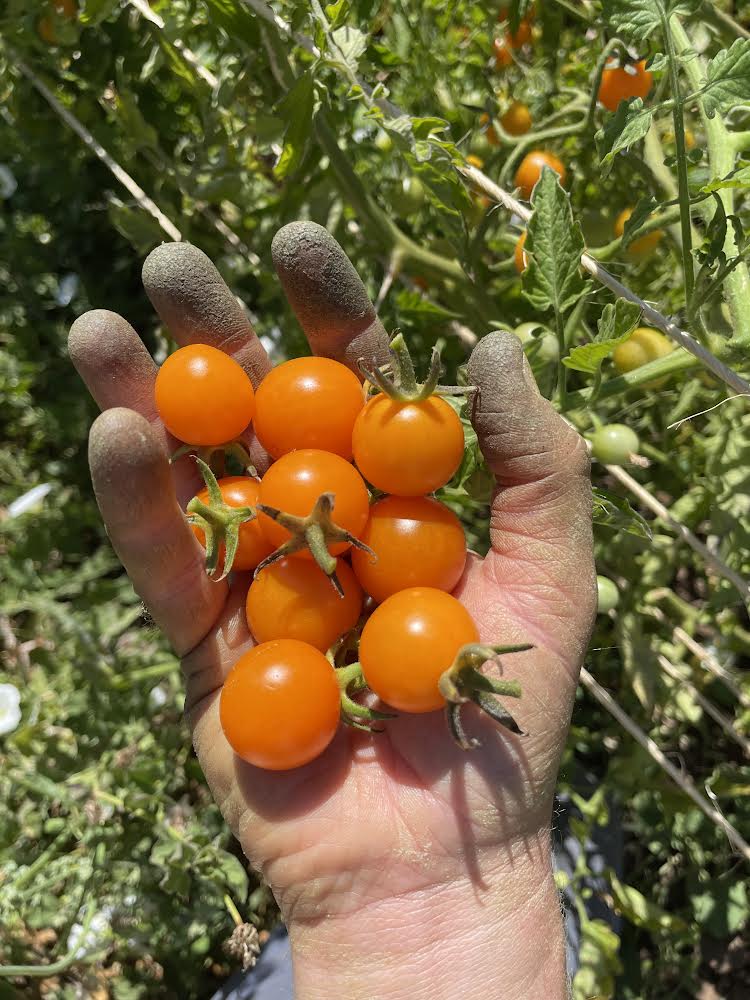
Hello Dearest CSA members!
I have been waiting to write this note, as the acceptance of a new transition is both intimidating and exciting to face. As many of you know, I began my career in farming through a pivotal apprenticeship during a High school summer on Hidden Villa’s production farm. That summer of learning and laughter inspired a career in this important work. I put my academic education on hold to pursue work on small organic farms on the NorCal Coastline in 2017. I began my internship at Hidden Villa in 2019 with a strident desire to gain more learning than the for-profit world could offer me. This work has provided me with expertise in the cultivation of numerous crops- mixed flowers, fruits, and veggies alike. Much of this work has been a “learning by doing” experience and equipped me with a significant aptitude for crop handling- harvesting, weeding, pruning, planting; green-house management, record-keeping, compost production, irrigation system maintenance, tractor operation, the management and teaching of interns, and product distribution through CSA, markets, donation, and wholesale models. When I think about how I fit into these kinds of agricultural systems, I pride myself in my competence for this grueling and imperatively valuable work.
As I have progressed into leading volunteers and farm tours with eager questions about the science and systems behind the work we do, I’ve realized that a gap in my knowledge restricts me from fully engaging in a dialogue around the foundation of our practices for soil regeneration and ecosystem health. I have determined that I want to strive towards a career that creates systemic change for disenfranchised folks who do not have access to nutrient-dense food and suffer predominantly from the negative effects of industrial agriculture. I am avidly dedicated to this work of combating climate change by restructuring our agricultural techniques, and as a baseline I believe that regional organic food available at grocery stores, farmers markets, or through CSA subscriptions cut down an individual’s carbon footprint impact. We see this through the reduction of international or extensive domestic transportation, extreme tillage from diesel-based mechanisms, and the use of chemical pesticides. Agriculture without petroleum-based additives decreases run-off into waterways which helps to enhance neighboring biodiversity. Access to affordable organic food provides a nutrient-rich option for families to strengthen their bodily health. Farms located in urban settings, open to their neighbors, are an educational opportunity for youth and adults alike- equipping them with an understanding of where their food comes from, how it is grown, and deepens their connection to nature and the land they reside on. This is nourishment for both the mind and the body. By choosing this life path of elevating responsible growing methods, I am defending my community against the proven harm that industrial and commercial agriculture has enacted against its land and peoples. Every community should have champions fiercely advocating for and exemplifying the work of growing food with an intent to HEAL.
And so, I have decided to take a big leap in this journey through farming- one in which I will go even further to work my brain like I have my body to equip myself with the dexterity of both a farmer and a scientist engaged at the forefront of regenerative agricultural work. The Agroecology B.S. degree at The University of California in Santa Cruz and the incredible resources that relate to my area of interest feels like the right next step in my trek to ensuring healthy and abundant food for everyone. I am going forth with my instincts and my heart, as I am scared when I look at the future of our agricultural systems and what they may mean for my future children and their own.
My position at Hidden Villa, from summer camp apprentice, to intern, to full-time Farm Coordinator has been instrumental in shaping the foundation for this future, and shaping me into the confident and determined person I am today. The support I have received from my teachers, and mentors and peers all along the way (looking at you Jason and Lanette!) is the only way that this path forth could have been carved. For now, I’m still around! I may be running around like a chicken with her head cut off- tackling online classes, working, and maintaining a joyful life, but I will continue to be dedicated to you and the people we serve through our programming and education through the remainder of this season. Thank you for cheering me on, supporting this work, and elevating the important mission of Hidden Villa.
With all of my appreciation,
Katie
CSA events summer 2023
CSA movie night – Friday July 21st
Floral design course for flower share members – Saturday, August 12th
Cob Oven Pizza Party – Friday September 8th
CSA 30th Anniversary Celebration and tomato tasting – Friday, September 29th *Please note this date has shifted by one day due to an HV scheduling conflict
In The Basket…
Sungolds: Do I even need to tell you what you already know? Try to save these candy-like jewels to share with the rest of your family. Our you-pick should open up in a few weeks and you’ll have plenty more!
Gravenstein Apples: I can’t believe we’re already at that time of year! These early tart gems come from our massive trees up ranch. Expect more next week.
Summer Squash: Added to any version of succotash is absolutely necessary!
Parsley: More than a garnish- an essential ingredient in your summer cooking.
Kale/Cabbage: A hybrid option this week as the squirrels unfortunately enjoy our brassicas as much as we do!
Cucumbers: I can’t stress this enough- refrigerator pickles!! Half salt water, half apple cider vinegar, a dash of red pepper, and some sliced garlic cloves. Enjoy all week.
Garlic: There’s never enough garlic in any dish in my opinion.
FOR THE PESTO
2 cups roughly chopped parsley
4 garlic cloves, roughly chopped
Salt and pepper
3⁄4 cup extra-virgin olive oil
FOR THE PASTA
1 pound spaghetti
2 tablespoons extra-virgin olive oil
3-4 cups medium squash, cut in 1⁄2-inch cubes
Salt and pepper
Large pinch of red-pepper flakes
1teaspoon grated lemon zest
4tablespoons grated bottarga (4 to 6 ounces) (if desired)
About 1⁄2 cup toasted bread crumbs (see Note)
Lemon wedges, for serving
Step 1
Make the pesto: Put parsley in a food processor or blender. Add garlic, a good pinch of salt, black pepper to taste, and olive oil. Whirl to make a smooth sauce. You should have about 1 cup of pesto.
Step 2
Bring a large pot of well-salted water to a boil over high heat. Cook spaghetti according to package directions until al dente, erring on the slightly underdone side.
Step 3
While the pasta cooks, put about 2 tablespoons oil in a large skillet over medium-high heat. Sauté the zucchini for about 2 minutes. Let it brown a little. Add salt, pepper, red-pepper flakes and lemon zest.
Step 4
Add drained pasta to skillet along with half the pesto. Toss everything together. Taste, and add more salt or pesto as needed. (Wrap and refrigerate any remaining pesto for up to 2 days or freeze for future use.)
Step 5
Divide pasta among individual plates and sprinkle generously with bottarga. Top with bread crumbs, and serve with lemon wedges.
Featured Flower
Pincushion Flower
Scabiosa atropurpurea
These sweet little blooms look good enough to eat. I love using them as accent flowers in bouquets and wedding boutineers. Katie has recently been experimenting with using the dark purple blooms as a natural dye. They produce an otherworldly blue that’s unexpected and really lovely. Enjoy!
-Lanette
Hidden Villa CSA
Week of July 24th, 2023
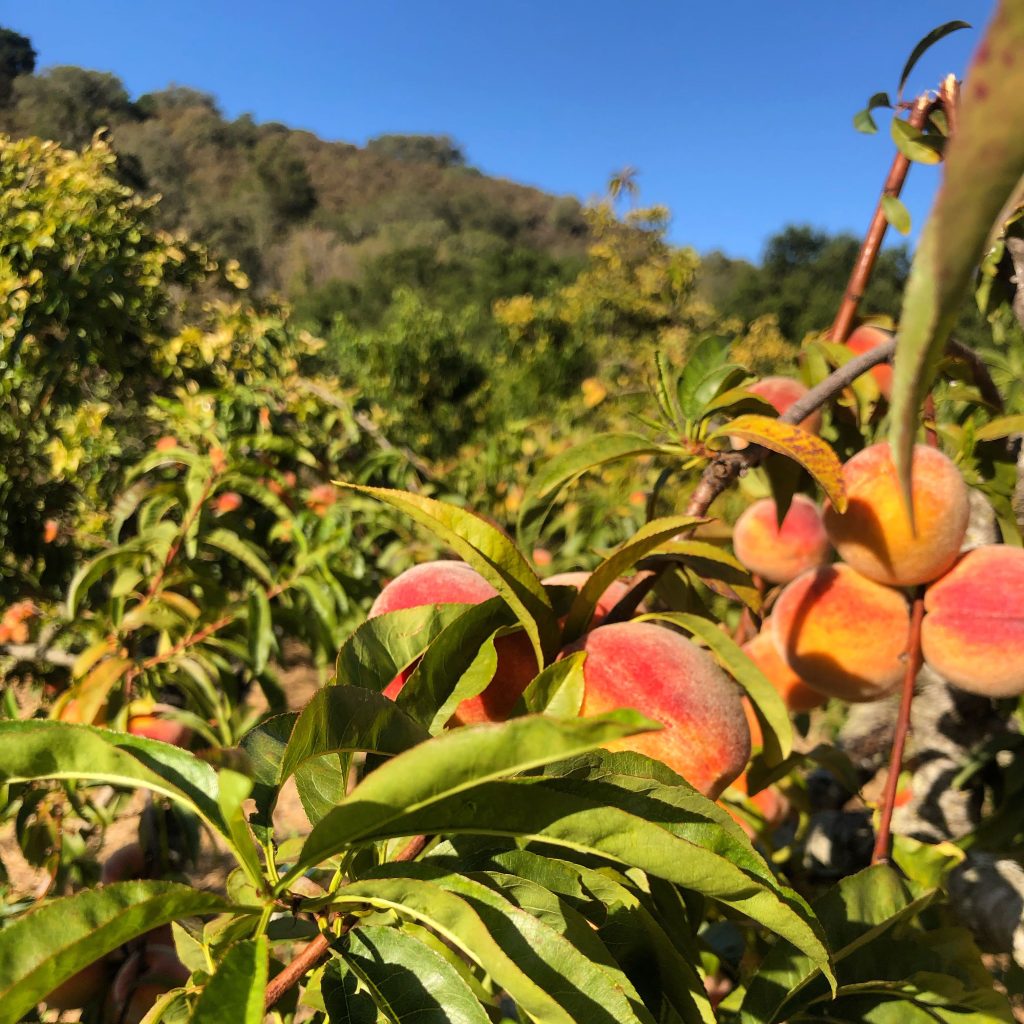
This past Friday night we hosted our CSA summer movie night. It was a lovely, warm evening. We shared the movie Look and See about Wendell Berry and his involvement in the movement for small-scale, regenerative agriculture particularly in his home, Henry County, Kentucky. Beyond the specifics of one man or one county, the film touched more deeply on themes of place and appreciating what it means to make a home. It all starts, as the film title suggests or encourages with pausing to look and see. I don’t have many heroes. I don’t tend to put people up on pedestals. But I’d say that Wendell Berry is as close as I’ve come. All of his work is imbued with a thoughtfulness and humanity that you can’t help but be inspired by. This movie only deepened that sense.
The discussion the group had afterward was as lovely as the movie itself. This is one of my favorite things about watching a movie with a group, the shared thoughts and questions after the credits have rolled. There were so many astute observations and questions. We discussed what makes a place a home, and how attention and appreciation are essential. Jason shared that the little bird feeder that he bought me as a gift recently has made our house more of a home by pulling us into watching the time pass as the birds flit by. Another attendee commented on the filming itself with cut-aways throughout to a craftsman making a beautiful wooden stool, illustrating the value of hand making a thing and the care inherent.
In a nod to Berry as a writer, the movie was laid out in chapters. Two folks misread one of the chapter titles, ‘Nowhere’ as Now Here. Or perhaps it was the correct read because then we mused on the idea of how appreciating a place transforms it from the former to the later. I love that thought.
For those of you who couldn’t make it, I’m including a poem of Berry’s below for you to enjoy. He’s titled it, “How to Be a Poet’ but if I can be so bold I might add the addendum, “How to be Present” as I think his wise words serve us all, poets or not. If you feel intrigued, here’s the link to rent the movie, it costs just a few dollars. Look & See
I hope you’ll consider joining us for the next CSA event, the cob oven pizza party on September 8th. Our CSA community is such a joy to be a part of. You all make me feel appreciative for this place and more a part of it.
-Lanette
How to Be a Poet
By Wendell Berry
(to remind myself)
i
Make a place to sit down.
Sit down. Be quiet.
You must depend upon
affection, reading, knowledge,
skill—more of each
than you have—inspiration,
work, growing older, patience,
for patience joins time
to eternity. Any readers
who like your poems,
doubt their judgment.
ii
Breathe with unconditional breath
the unconditioned air.
Shun electric wire.
Communicate slowly. Live
a three-dimensioned life;
stay away from screens.
Stay away from anything
that obscures the place it is in.
There are no unsacred places;
there are only sacred places
and desecrated places.
iii
Accept what comes from silence.
Make the best you can of it.
Of the little words that come
out of the silence, like prayers
prayed back to the one who prays,
make a poem that does not disturb
the silence from which it came.
CSA events summer 2023
CSA movie night – Friday July 21st
Floral design course for flower share members – Saturday August 12th *Please note this date has shifted by one week due to an HV scheduling conflict
Cob Oven Pizza Party – Friday September 8th
CSA 30th Anniversary Celebration and tomato tasting – Saturday September 29th *Please note this date has shifted by one week due to an HV scheduling conflict
In The Basket…
Frost Peaches– This early variety is best eaten when the fruit is still a little firm. They tend to get a tad bit mealy as they soften.
Basil– Pesto time!
Potatoes– When it’s hot and I don’t want to further heat the house with the oven I opt for steaming our potatoes and making a salad. The onions could be a nice addition here too.
Red Onions– Any extra tangy variety, great sliced thinly on sandwiches and they caramelize into a rich flavor in sauces.
Cucumber– Combine the cukes and onions for a quick refrigerator pickle.
Strawberries– Eat and enjoy, no preparation needed.
Lettuce– A fresh salad is just the thing on a hot summer day.
Refrigerator Pickles
- 2-3 cucumbers, depending on size
- 1/4 cup sliced onion
- 3 sprigs dill
- 1/2 cup apple cider vinegar
- 1/2 cup water
- 2 cloves garlic, smashed
- 1 1/2 tsp salt
- 1/4 tsp sugar
- 1/4 tsp whole black peppercorns
- 1/4 tsp whole yellow mustard seeds
- Pinch of crushed red pepper flakes
Pack a clean pint-sized jar with sliced cucumbers, onion slices, and dill sprigs. Leave a 1/2 inch of space at the top of the jar for liquid.
In a small pot heat the vinegar, water, garlic, and all spices until the mixture comes to a simmer and salt and sugar dissolve.
Cool the brine down to warm and fill the jar so everything is covered with brine.
Close the lid tightly and refrigerate for 24 hours before eating.
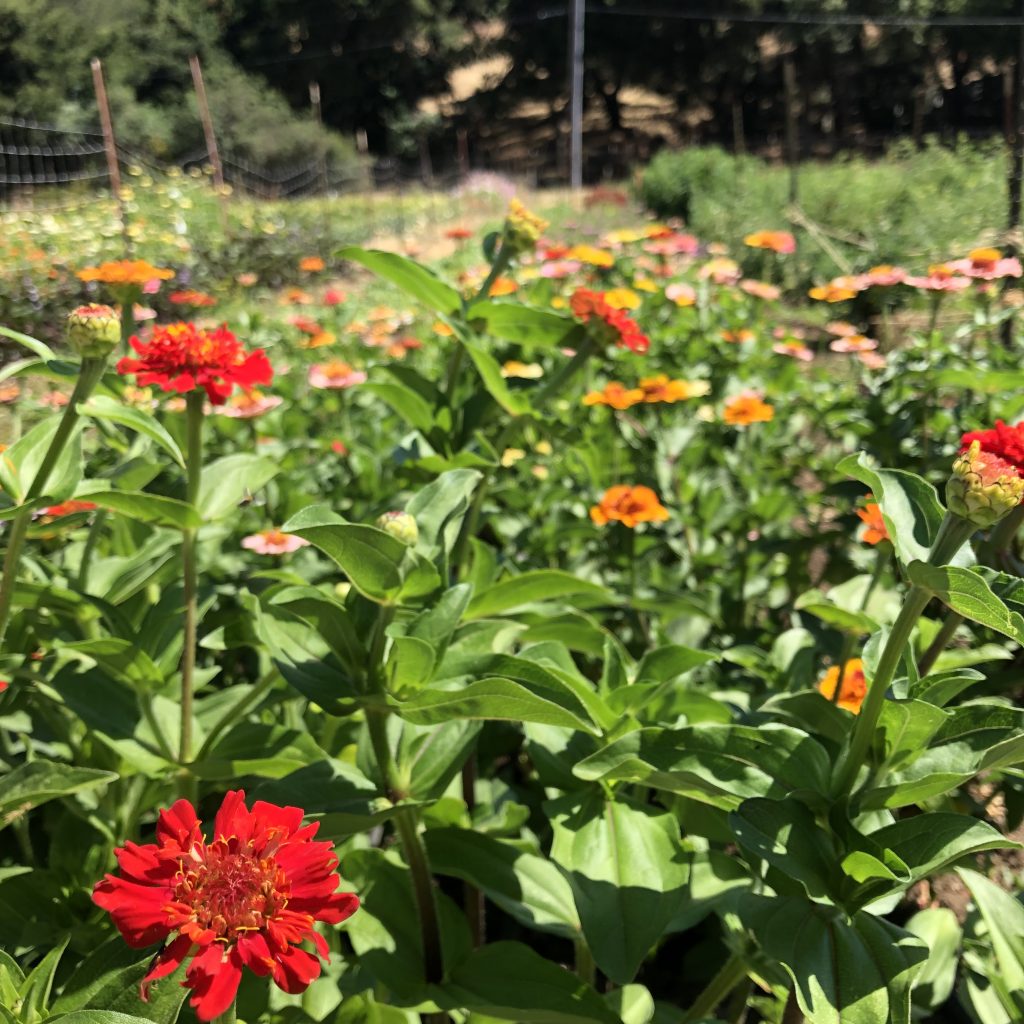
Featured Flower
Zinnia
Zinnia Elegans
Tried and true, zinnias are one of the first flowers I ever grew and I’ll grow them every year I’m able. I love their rainbow of colors and their hardiness. They don’t require much water, trellising or any special care and they’ll still produce beautiful blooms all summer long.
-Lanette
Hidden Villa CSA
Week of July 17th, 2023
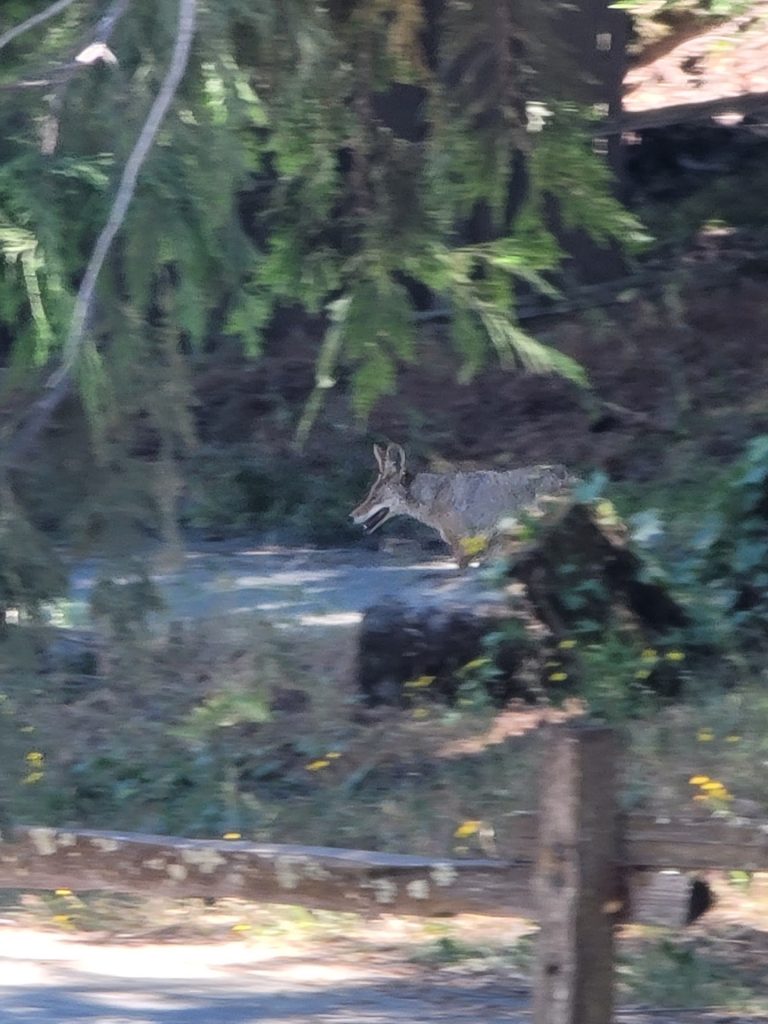
Lanette and I were out in the field last night checking on a few irrigation things and we saw a coyote lurking around outside the field across Moody road. Even from a 200 foot distance we could see that the animal was scrawny in a characteristic way but healthy and brisk. Her ruddy coat shone duskily in the twilight and she kept eyeing us to make quick necessary evaluations-were we a threat, were we going to intervene in her hunting? We watched as she dug intensely, like a dog at the beach, and retrieved a gopher or maybe a baby squirrel from the burrow she was excavating. Then she wolfed down her dinner. Very few, if any bites. We heard as she rounded the outskirts of the field down towards the creek, a chorus of protesting squirrel alarm calls. I was just saying to Lanette that we should strive to make our deer fence more porous to friends like this when the coyote popped up near our compost piles over by the creek, clearly inside the field. She continued to keep a close eye on us as I filmed her walking among the compost windrows. So like a dog to find the barely edible but oh, so appealing scraps of the compost pile and chew them down with that weirdly side-eyed molar grind.
What a beautiful animal and such a treat to observe these behaviors. This experience felt like a deep affirmation, a validation from the natural world around us that yes, we are providing sustenance in many attractive forms to this skulky and mischievous predator who is clearly thriving as a result. Cut to the seagull-like cries of the multiple fledging red shoulder hawks who are embroiled in their rodent hunting training program over the 2 acre field. Katie is so enamored by them that it is infectious. Not an hour goes by on the farm these days without hearing them wheel and cry with a tone that seems to have equal components of “Mom, feed me” and “look what I can do!”
Last week we were riding the cart up to lunch and Lanette shouted to keep me from running over a juvenile snake who was resting in the hot road. We ground quickly to a halt attracting the attention of one of our camp counselors who came over to see as we tried to shoo the reptile to a safer, low traffic area. It was a little gopher snake with the characteristic brown mottled markings. As growers we view these snakes in a particularly fond light. I’d estimate by size that this snake was like a 12 year old person. He was unresponsive to our closeness and pretty clearly asleep, whatever that is for snakes. I grabbed a stick and gently approached him to escort him to the safety of the roadside. Suddenly he awakened and in a split second his entire vibe changed into something dramatically aggressive. He coiled intensely and began rattling his rattle-less tail. Even the look of his head seemed to take on a more serious diamond-like shape. After a minute of fighting that included a couple of strikes at the stick, he turned tail and zipped into the scrub by the roadside. To this moment we are still questioning what kind of snake this was. If there were Oscars given for best animal performances I would nominate him. I am glad to know that he is out there.
Farming in a wild, natural environment is limitlessly challenging. We all try our hardest to respect and learn from the plants, animals, even the fungi and microorganisms that adapt and thrive best here. Sometimes it feels like it is just enough to bear witness to them and to try and give them the reverence that they are due. -Jason
CSA events summer 2023
CSA movie night – Friday July 21st
Floral design course for flower share members – Saturday August 12th *Please note this date has shifted by one week due to an HV scheduling conflict
Cob Oven Pizza Party – Friday September 8th
CSA 30th Anniversary Celebration and tomato tasting – Saturday September 30th
In The Basket…
Fennel Bulb: In a culinary sense I often think of fennel bulb as “licorice flavored celery.” Meaning that fennel bulb can be eaten raw in salads or roasted or caramelized like celery often is in making a soup or sauce stock. The distinctly Italian spectrum of flavors lend it well used in marinara or alfredo sauces. Heck, I can even imagine the pulled stem cups making a delicious ants on a log version with almond butter and sultanas. For lunch today Lanette made a salad with lettuce, shaved fennel, cucumber topped with a shiro plum vinaigrette. So recommend it.
Walla Walla sweet onions: Enjoy the drying greens as you can before they are gone. The bulbs are extra sweet these days.
Shiro Plums: Yellow Japanese plums that enjoyed the lucky attribute this spring of flowering during a brief respite in the hard rain so they could be successfully pollinated. Sweet tart and great for fresh eating or in salads.
Oregano: I wanted to include oregano this week because it is vital to my recipe. Reminder that while fresh oregano has many unique attributes these bunches can also be dried and used in sauces or with beans.
Summer Squash: I imagine that people are getting fairly tired of this vegetable at this point and so I am including an old favorite recipe for summer squash fritters.
Head lettuce: For this week’s salad
Chard or beets: This spring’s chard patch is on its way out and I wasn’t sure if we would have enough to give to everyone so it’s either chard or beets this week.
Cucumbers: Lemon cucumbers are pale yellow round cukes that make crisp delicious fridge pickles. The green slicers are great for salads.
Summertime
Summer Squash Fritters
- 3 medium size summer squashes grated
- 1/2 cup finely minced sweet onion
- 3 eggs
- 1/1/2 cups of masa harina (tortilla making ground corn)
- 2 t salt
- 1 T finely minced fresh oregano
- 4 oz crumbled feta cheese
- Optional 1-4 t cholula hot sauce
- olive oil for frying
In a large mixing bowl, grate the squash. Prepare the onions and coat them in the salt. Let marinate for 5 minutes. Prepare the oregano and the feta. Combine the onions with the squash and crack the eggs into the bowl. Add the oregano, feta and hot sauce if desired, mix thoroughly. Add the masa and gently stir in to combine thoroughly. Heat a large skillet over medium high heat. Coat the bottom of the skillet with olive oil. I like making the fritters in kind of a hot dog shape which I find nicely presentable but how ever you choose to fry them it should be about 1/4 cup of material for each fritter because this size, flattened and pressed with a spatula makes the best golden brown, tasty fritter. Fry as many as you can fit in your skillet at a time 4 minutes per side until golden brown. Serve with sour cream or salsa and maybe that delicious plum dressed salad.
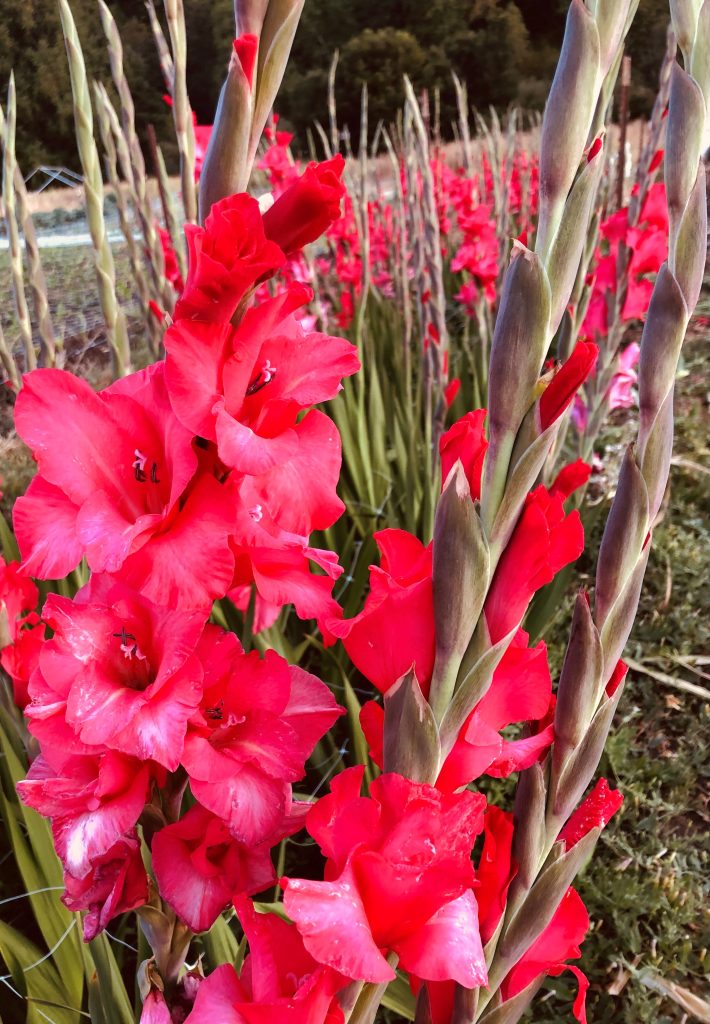
Featured Flower
Gladiola
Gladiolus spp.
I haven’t grown gladiolas many times in my career. The price of bulbs was really my main impediment. When you’re growing on our scale you have to think in terms of hundreds of bulbs and that adds up fast. But I’m really glad I did this year. Every person who sees them exclaims in joy! There’s clearly something special about them. And I love their tropical feel, it makes me think of vacation and drinks on the beach. I hope they transport you as well.
-Lanette
Hidden Villa CSA
Week of July 10th, 2023
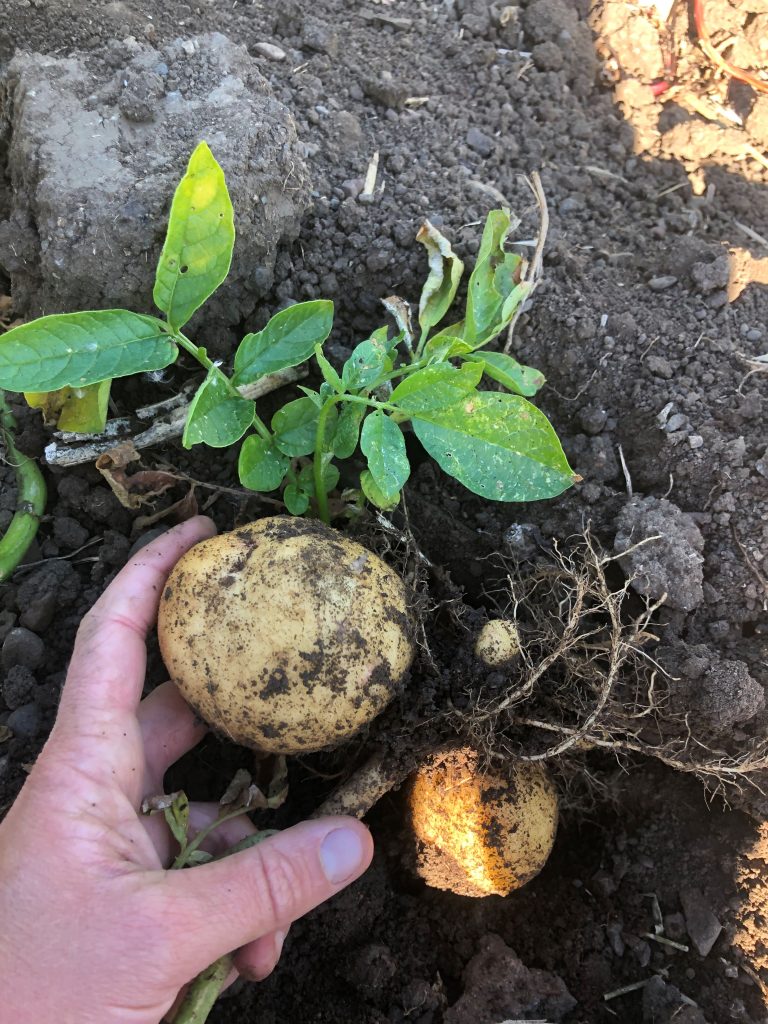
Potatoes are my absolute most favorite crop to harvest- although it is heavy and grueling work! To pull each bush out of the ground to discover the treasures that reside beneath the surface, is the quintessential satisfaction that a farmer seeks to make all of this hard work worth it.
Since I started farming at Hidden Villa, Jason and Lanette have opened the day of each years first potato harvest with a reading of Pommes de Terre by Edward Abbey. This is the second harvest (of a few more to come!) of potatoes this season- please think of Edward Abbey’s words as you enjoy them on your own plates this week:
Pommes de Terre
by Edward Abbey
The plow; the raw September earth; the massive-haunched and mighty-hoofed old bay clomping and farting down the furrow; Father holding the plow, my brother the reins, and me with a sack following, gathering the fruits of the overturned soil – the earth apples…
Richly abundant, brown fat potatoes, thick as stars, appearing like miracles out of the barren, weedy, stony patch, thousands of big hefty solid spuds, bushel after bushel, a hundred bushels per acre, a mass of treasure from the earth…
How our hands and eyes delighted in that harvest, how gladly we dragged our bulging gunnysacks to the wagon…a wagonful of potatoes! Dark, crusted with dirt, soil, earth, cool to the touch, good to eat even raw; we plowed the shabby-looking field and turned up nuggets, plenty, abundance, more than we needed, riches unimagined…
Enjoy your apples of the earth!
-Katie
CSA events summer 2023
CSA movie night – Friday July 21st
Floral design course for flower share members – Saturday August 12th *Please note this date has shifted by one week due to an HV scheduling conflict
Cob Oven Pizza Party – Friday September 8th
CSA 30th Anniversary Celebration and tomato tasting – Saturday September 30th
In The Basket…
Potatoes: Some of the biggest and most beautiful we’ve ever grown!
Summer Squash: They keep on producing more and more! Zucchini was the first crop I ever grew in my family’s community garden as a child- enjoy them grilled, in soup or covered in cheese!
Strawberries: This crop may be the most successful I’ve ever seen, and I’m going to attribute that to the amazing rains that kept them well watered all winter.
Lettuce: Slice these dense heads in half and grill them on their open face until leaves are slightly charred. Top with cesar!
Purslane: Don’t knock it ‘till you try it! The lemony crunch of purslane is the perfect addition to any good potato salad.
Garlic: These nearly cloved-up bulbs are in a funky inbetween stage. We will harvest the rest at the end of this week to hang and dry for storage garlic!
Mint: Mojitos sing Summer. Also, check out the recipe for how to incorporate them in a delicious yogurt sauce.
Cucumbers: First of the season and deliciously refreshing! You know what to do.
Garlic, Mint, Cucumber Yogurt Sauce
- 1 Cucumber, grated or finely diced Salt
- 2 Cups yogurt
- 2 to 3 garlic cloves, cut in half and mashed to a paste in a mortar and pestle with ¼ teaspoon salt
- 2 tablespoons chopped fresh mint (more to taste)
- Freshly ground pepper
- 2 tablespoons extra virgin olive oil
Toss the cucumber with a generous amount of salt and leave in a colander in the sink to wilt for 15 to 30 minutes. Rinse and drain on paper towels.
Beat together the yogurt, garlic, mint, salt and pepper to taste, and olive oil. Stir in the cucumbers. Adjust seasonings and serve with lamb meatballs, pita, or any rich curry based dish.
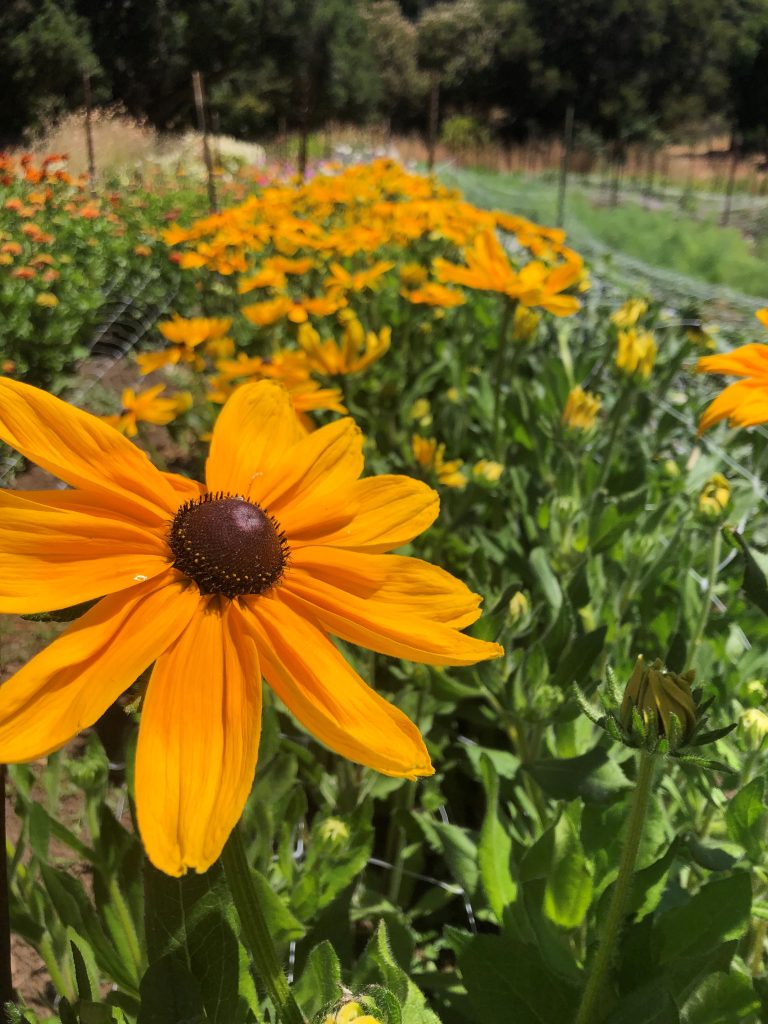
Featured Flower
Indian Summer
Rudbeckia hirta
Last week I featured the ‘Sahara’ variety of rudbeckia. This week it’s their sunnier cousin’s turn. I have been growing these happy flowers for years now and have come to love and rely on them as a summer staple. I especially love their Hershey kiss center, which looks positively edible. You can expect to see these in the bouquets for weeks to come.
-Lanette
Hidden Villa CSA
Week of July 3rd, 2023
I believe that the community – in the fullest sense: a place and all its creatures – is the smallest unit of health and that to speak of the health of an isolated individual is a contradiction in terms. -Wendell Berry
When I first began farming at Hidden Villa as an intern back in 2008 I was very focused on food. Learning to grow our multitude of vegetables and fruits, experimenting with cooking, honing my skills with all of the specific harvest techniques for each crop, pouring over seed catalogs to study different varieties. My love of flowers would come later as would my deep dive into understanding soil health. It all started with food. In fact, before I came to Hidden Villa and before I apprenticed at the organic farm at UC Santa Cruz I fell in love with the pleasure of enjoying good food while working as a waitress at Chez Panisse right after college. A privileged introduction to be sure. Working there was a magical experience. Arriving at the restaurant and walking beneath the beautiful redwood trellis and gnarled wisteria that fronts the building I often felt like one of the lucky children from Willy Wonka and the Chocolate Factory, getting to see the behind the scenes magic of such a storied institution. The wait staff have daily meetings with the chefs to review the menu and discuss the seasonally shifting offerings. I learned so much through those meetings. But even more impactful were the family style meals we all shared each night at the end of the shift. The waiters, chefs, cooks, everyone sat down together with a glass of wine and a full plate to eat and talk. We shared the same amazing meals that guests had enjoyed at the restaurant that evening. The agro-ecology classes and watershed management books I’d read in college had fostered in me a belief in the importance of regenerative agriculture and a commitment to learn more, but it was those meals and the joy of delicious, seasonal food, lovingly prepared and shared, that won my heart and inspired me to continue down the farming path.
Over the years of working on the farm and eventually co-managing the CSA my focus has shifted some from the ‘A’ in agriculture of the CSA to the ‘C’ of community. Of course providing delicious produce and beautiful flowers will always be at the heart of what we do. But increasingly I’m inspired by the potential those goods have to nurture connections and build community. There are the connections built when folks gather around a table to share a meal as I did with my coworkers at Chez Panisse, or in giving a friend a bouquet to celebrate a milestone or wish a speedy recovery. There is the connection that eating this food engenders in us to this place, linking us to the seasonality of our little valley and to this specific year. There is also the very meaningful potential for this farm to reconnect us to the natural world and our place in it, both as recipients of its bounty and as stewards and community members in this agro-ecosystem. In so doing we are benefitting from the healing that’s possible as we participate in a relationship with the natural world that’s constructive. And as I was happily reminded of last weekend with our CSA field walk, this farm can serve as a place for us to connect with one another. Perhaps farms are especially suited to do so, as natural spaces that we are elementally connected to as sources of our sustenance. It was a pleasure to spend Saturday morning touring the fields with some of you and to gather around our farm picnic tables to share a meal afterwards. Your questions and conversations communicated your appreciation for this place and care for this work. That is so heartening to me.
This work is hard especially this time of year with its long, hot days in the field. Reconnecting to this community and spending time together was as nourishing as a good meal. I look forward to more opportunities to connect as a CSA community. I hope you will all consider joining us for any of the upcoming events that interest you. You are invited and welcome.
In community, Lanette
CSA events summer 2023
CSA movie night – Friday July 21st
Floral design course for flower share members – Saturday August 12th *Please note this date has shifted by one week due to an HV scheduling conflict
Cob Oven Pizza Party – Friday September 8th
CSA 30th Anniversary Celebration and tomato tasting – Saturday September 30th
In The Basket…
Summer Squash: Grilled summer squash on toasted sourdough bread with slightly meleted cheddar cheese and little bit of mayo and/or mustard is a total crowd pleaser.
Strawberries: So sweet and perfect, no preparation required.
Cabbage: Just in time for slaw! See the recipe below.
Onions: They are so big and beautiful this time of year, they’re positively gleaming. At least once a summer I have to make onion rings, and this might be that time.
Basil: The first cut of basil this year, later than usual given our late spring. There’ll be lots more to come for pesto and Caprese salads. I’d suggest using this little bit as a garnish for potato or pasta salad.
Fennel: Such an underappreciated bulb. I love to caramelize it with onions for a good long time, 20 minutes or more, adding water as I go to cool the pan and put it on toast with maybe a little bit of goat cheese. Divine!
Lettuce: On these hot days a refreshing salad is exactly what I want. If you haven’t eaten all the berries before you get home you could add them to some balsamic vinegar, olive oil and salt and blend for a sweet dressing.
Cabbage & fennel slaw with
pink strawberry balsamic dressing
- 3 cups of finely minced cabbage, or use a mandoline if you have one
- 1 fennel bulb julienned
- 2 TBSP fennel greens
- 1/4 cup coarsely chopped walla walla onion bulb
- 2 TBSP olive oil
- 2 TBSP mayonnaise
- 1 TBSP balsamic vinegar
- 3 large strawberries
- salt to taste
- optional black pepper and/or ribboned basil
Prepare the cabbage and fennel. Combine all the other ingredients into a blender and puree to a fine constancy and salt to taste. Toss the dressing on the cabbage and fennel and mix thoroughly. Allow to chill and marinate for at least an hour in the fridge, longer if you can, before serving. Pair nicely with grilled chicken. Enjoy!
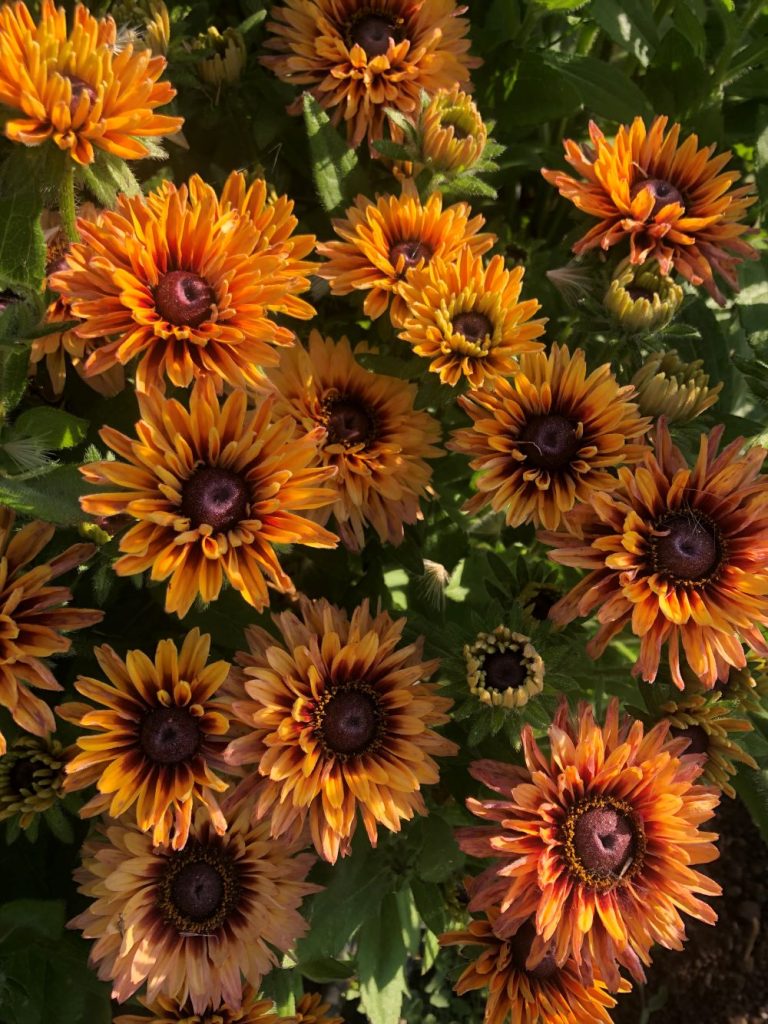
Featured Flower
Sahara Rudbeckia
Rudbeckia hirta
Rudbeckia, also known as black eyed susan, don’t get the repect they deserve in my opinion, especially this stunner. I absolutely love it! Although the colors are decidedly autumnal, when they are combined with pastel shades I think they make beautiful bouquet for any season. We seeded these last fall and planted them into the field in October. They were able to handle the cold winter and just started blooming last week.
Hidden Villa CSA
Week of June 28th, 2023

Wood is the Future
We are so proud and happy about how this method that we have been employing to build soil over a 2-3 year period is improving soil fertility and composition, reducing disease pressure, developing fungal colonies, and enhancing our animal husbandry programs. If you have been a share box member for more than this year, then I apologize in advance for my redundancy in our process of soil building, but I have to admit that it fascinates and energizes me.
The method I am referring to is our strategy of employing what would be landfill-bound local arborist wood chips to smother the ground with 3-4 feet thick wood chips over a roughly 1/4 acre patch of worn out soil every year. This practice that we arrived at through trial and error has now become a regular part of our rotational strategy that is long term rotation. I really don’t know if this works in other climates and soils but for us we apply these thick sheets of wood chips, any mixture of wood species, and allow them to decompose over a 2-3 year period in our fields. Over this period chickens and pigs are ranged selectively over these huge piles of carbonaceous matter. The animals root, scour, scrape, dig, and poop through the materials and particularly during the rainy season, this initiates and accelerates a fungal decomposition of the materials. One key to the success of this process is to NOT disturb the soil prior to laying out the massive amount of wood chips. Something about the native population of soil organisms at the surface seem to be capable of expeditiously decomposing wood chips and converting them into nutrient dense soils. After this period of rest and animal grazing, these areas become the new sites for our plantings of the most disease sensitive and nutrient-hungry crops that we grow including strawberries. This is my proud 4th of July proclamation, our farm fireworks! Soil building and carbon sequestration can be paired and become the same process to simultaneously grow better, healthier crops and embed carbon permanently within our agricultural soil systems.
With the fire mitigation work that we engaged last year to prune enormous portions of Hidden Villa vegetation and establish shaded fire breaks over our most used areas, I have been thinking a lot about how land management strategies could be directly employed for climate change mitigation. What could be more patriotic? In my own observation all tree and understory vegetation within forests responds positively to selective pruning. I know it’s counterintuitive for us humans to relate to but plants enjoy a health benefit from having 5-30% of their branches and leaves removed every year. Maybe it is a function of removing diseased or damaged growth, maybe it is a hormonal stimulation that comes from cuts, maybe it is redundancies of growth that compete with each other, maybe it is co-evolutionary pressure from browser feeders, maybe it is something that we have yet to comprehend, but plants almost universally respond to selective pruning with more vigorous growth. More vigorous growth means more vigorous photosynthesis which extracts carbon from our atmosphere and transforms it into the tissues of plants, especially wood. I believe we should be dedicating efforts as humans capable of conducting selective pruning on every tree and bush we can to capitalize on the existing plants we already have on earth to pull more of the carbon out of the air that we have foolishly burned and put there.
This is a vision for a climate proactive, government funded workforce. Maybe we can call them Arbornauts. They would be forest managers and stewards who would work through specific forest areas each year to remove dead, dying, diseased and disoriented branches from trees and understory growth and deposit the woody materials on the forest floor so that it can decompose in place, enhance the soil ecosystem, sequester carbon and minimize the impacts of wildfire events. The bolstered annual growth of the forests would scrub tremendous amounts of carbon from our atmosphere eventually sequestering it in the soil systems of our forests. Accessible amounts of the carbonaceous material could also be converted into biochar in “curtain burner” devices (these are basically enormous shipping containers specifically designed to process scrap wood under heat into charcoal) and reapplied to forest floors and meadows to simulate the most beneficial effects of wildfire. Ultimately one of our best tools in fighting climate change can be our alliance with and stewardship of plants. We cannot conduct photosynthesis. Photosynthesis is the way that carbon has been removed from earth’s atmosphere before, like 330 million years ago, and it can happen this way again. Can we please make it our job to help the plants help the planet?
In The Basket…
Summer Squash: My thing throughout the summer is grilling squash. I even grill slabs of thickly cut squash tossed in olive oil and salt when I am grilling something else so that I have the squash on hand for adding to pasta or quinoa salads, sandwiches, or casseroles like lasagna
Strawberries: The plants are really starting to establish themselves!
Lavender: Beautiful flowers with lots of baking and culinary uses. Lavender shortbread is amazing. Lavender infused whipped cream is heavenly. I have even had lavender as part of a spicy dry rub on pork loin. If none of that appeals to you it may be dried and kept around your kitchen for its uplifting aroma.
Lambsquarter: I think this is my favorite edible weed we have on the farm. I consider these amaranth family cooking greens to be a flavor combination of spinach and green beans. Chop the greens and stems and lightly saute in a little olive oil until tender. The leaves naturally produce oxalic acid on their back sides that feels kind of dusty and contributes mightily to their health benefits.
Beets: Bunches of red, golden, or chioggia beets for boiling or roasting
New Potatoes: Keep new potatoes in the fridge before using them. These young potatoes make awesome fries, roasties or even mashed potatoes.
Walla Walla Onions: Sweet onions for all of your oniony purposes! Don’t forget to eat the greens.
Lambsquarter Mac and Cheese
I know it doesn’t have the culinary prestige of many of our other recipes but this will be a guaranteed way to get your younger kids to eat an obscenely healthy wild green!
- 1 lb dried pasta-elbow macaroni or fusili or orechiette is my son’s favorite
- 1 large bunch of lambsquarter
- olive oil
- 6 oz sharp cheddar cheese
- 1 oz parmesan or asiago cheese
- 1 T butter
- 1 cup milk
- 2 T sifted flour
- salt
- 2 t dijon mustard
In a large soup pot boil ample water for the pasta. Prepare the lambsquarter by chopping the greens and stems finely. Saute the lambsquarter in a large skillet over medium heat with a little olive oil and sprinkle of salt. Stir and saute cooking the greens until tender 8-10 minutes. In another skillet begin melting the butter over low heat. When it has melted add the milk and raise the heat slightly. Grate cheddar and asiago into the milk and add salt to taste probably 1/2 t. Stir this sauce gently and constantly with a whisk. After a five minutes the cheese should begin melting and blending into the sauce. Add the flour and whisk in more vigorously. The heat should catalyze the thickening of this mixture in about a minute but continue whisking to achieve a silky texture. You may need to add a little more flour if it is not thickening or a little more milk if it is too thick. When you have gotten the right consistency turn the heat off and whisk in the mustard. Meanwhile hopefully your pasta is finishing up al dente at about this point. Strain the pasta and combine the sauce, greens and pasta in a large bowl and mix it up. Serve. If you want to turn up the appeal of this one transfer the whole mixture to a casserole pan and coat the top with a mixture of 2 T melted butter, 2 oz grated asiago cheese, and 1 1/2 cups of bread crumbs. Toast the top of this golden brown in a 375 degree oven for 10 minutes.
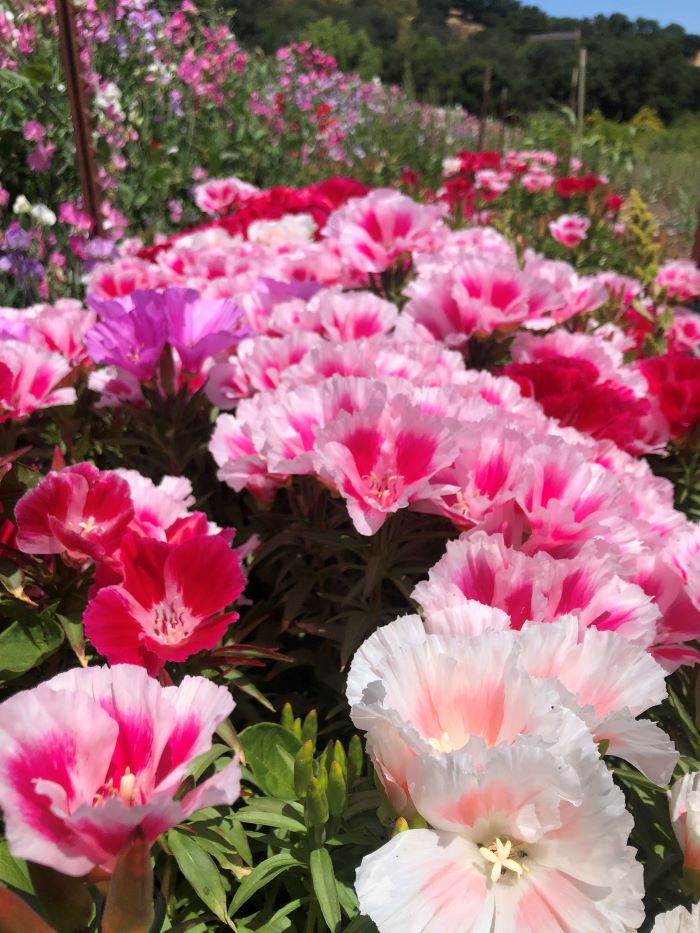
Featured Flower
Godetia
Clarkia amoena
I am so proud of our godetia crop this year. We have grown it before but never had such long stems and in such abundance. I think we got the timing just right. I feel like this flower has a tropical spirit despite thriving in this arid climate. We will definitely be growing more in the future.
Hidden Villa CSA
Week of June 21st, 2023
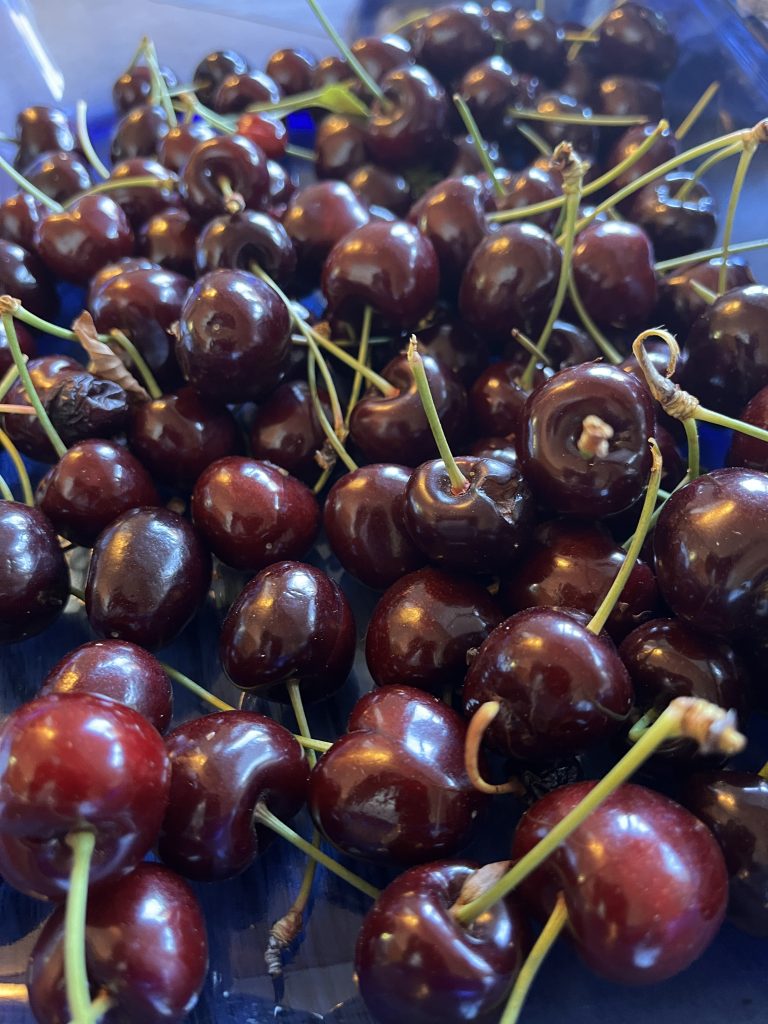
Cherries! What an exciting treat for you all to experience- this will be our first year offering the full swathe of our CSA members a basket of cherries in their share. I started working at Hidden Villa when many of the cherry trees we are harvesting from were young and unproductive. As is the name of the game with orchard crops, we have patiently pruned, protected, irrigated, and awaited the abundance we knew would come. Each year these trees produced more and more, but a sizable quantity was never procured due to the immense appeal of this truly ruby fruit to our crow and song bird residents. For many of you who pick up at the farm or visit often, you may have noticed an increased addition of netting scattered across the row crops and trees- it feels like our 5-acre field is nearly covered in entirety with the stuff. This certainly isn’t the most attractive way to ward off pests, but we have discovered through much trial and error that its effectiveness is almost full-proof and our only chance of saving the crops like cherries, tomatoes, watermelon, strawberries, and squash that are so desirable to our flapping frenemies
I regard crows as “frenemies” because in so many ways they cross the divide between friend and enemy. They enjoy the fruits of our labor as much as we all do, but without the delicate touch of our harvesting hands. They can ravage entire plants into a demise we can’t save them from, and often take a little nibble out of hundreds of individual fruits and veggies. They poke holes in our irrigation in search of a water source, and they scare away the song birds that keep our invasive insect populations at bay. But the crows, like everything in balance with nature, serve to support us as well. More carnivores than one might expect, I have also known our crows to attack our ever growing population of rodent pests. Just the other day as I was spading up some beds with the tractor in preparation for a big corn planting, the crows patiently perched around me waiting for the guaranteed un-earthing of 2 gophers. In seconds these gophers were swarmed and “dealt with” before I could even get off the tractor and take care of it myself. I nodded to the crows in thanks, and I’d like to think that they could understand my appreciation. It’s a complicated relationship- but one I am trying to learn from. The amount of crows inhabiting the surrounding areas of our farm are impossible to mitigate in any meaningful way- so how do we coexist with them? For starters, the work to establish the net barrier has proven immensely worthwhile. It’s an organic and reusable method and after many battles with the tangles we have become near professionals at positioning it successfully. And so, we coexist with the crows and ravens in a squawking sort of peace.
Despite the many losses and frustrations we have come face to face with at the beaks of these flapping feasters, I still feel intrigued to learn from their tactics and tendencies and maintain patience for their tenacity and drive for destruction. They took up home here long before I did and will continue to inhabit this space long after I am gone. So for this time that I work at Hidden Villa, I can adjust and work with the organic barriers that can be established to allow us all to reside in harmony. From all of this learning, each of you gets to enjoy the absolute delicacy of a basket of cherries- savor every bite just as the crows would!
-Katie
In The Basket…
Cherries: Cherries are in abundance across every farmers market right now, but the season is fleeting and unfairly delicious. Enjoy fresh and find more to enjoy the recipe below!
Summer Squash: The abundance begins! Zucchini’s were the first plant I grew in my family’s community garden as a child.
Broccoli/Cauliflower: Either/or this week! This cool weathered spring has created excellent conditions for our flowering brassicas.
Green Garlic: They’re really shaping up into full bulbs. Savor the greens in salad dressing or chopped up into a butter coating for a roast chicken.
Lemon Verbena: The fruitiest herb, perfect timing to match the tart of the cherry!
Dino Kale: Massage intensely with lemon, olive oil, sea salt for the base of every delicious massaged kale salad!
Strawberries: The biggest berries debut the season.
Lemon Verbena Infused Whipped Cream w/ Cherries Jubilee
Lemon Verbena Whipped Cream:
- 2 cups heavy cream
- ½ bundle lemon verbena
- 2 tablespoons sugar
Wrap lemon verbena leaves in a towel and crush slightly to bruise them. Heat cream over medium-high heat until it begins to boil, stirring constantly so the cream does not scald. Add lemon verbena leaves, submerging them in cream. Turn off heat.
Cover tightly and let sit for a half-hour. Strain, pressing out juice in leaves. Refrigerate until very cold, about 6 hours. Place cold cream and sugar in a mixer and whip until it forms peaks.
Cherries Jubilee:
- 1 small orange
- 4 cardamom pods
- 2 tablespoons unsalted butter
- 1 to 2 tablespoons granulated sugar, to taste
- 1 basket of Cherries
- 2 tablespoons Cognac or brandy (optional)
- Salt
Finely grate about ¼ teaspoon zest from the orange, halve the fruit, and squeeze out 2 tablespoons juice. Place the cardamom pods on a cutting board and use the side of a knife to lightly press on them until slightly crushed. In a skillet over medium heat, combine butter, sugar, cardamom seeds and pods, and orange juice. Gently stir the mixture until the sugar dissolves, 2 to 3 minutes.
Add the cherries and orange zest to the saucepan. Cook cherries until they become tender and release their juices, 2 to 5 minutes. Turn off the heat and leave the pan on the stove.
(Optional) Pour Cognac or brandy into a big metal ladle capable of holding 2 tablespoons of liquid, or a small saucepan. With a stick lighter or long match, carefully warm the brandy by gliding the flame directly over the liquid (stand back as you do this). When the brandy is warm enough, it will ignite with blue flames. Immediately pour the flaming brandy over the cherries and allow flames to burn off, about 30 seconds to 1 minute.
After the flames have died, turn the burner to medium heat and reduce the sauce until it begins to thicken, 1 to 2 minutes. Add a tiny pinch of salt to taste and pair with lemon verbena whipped cream.
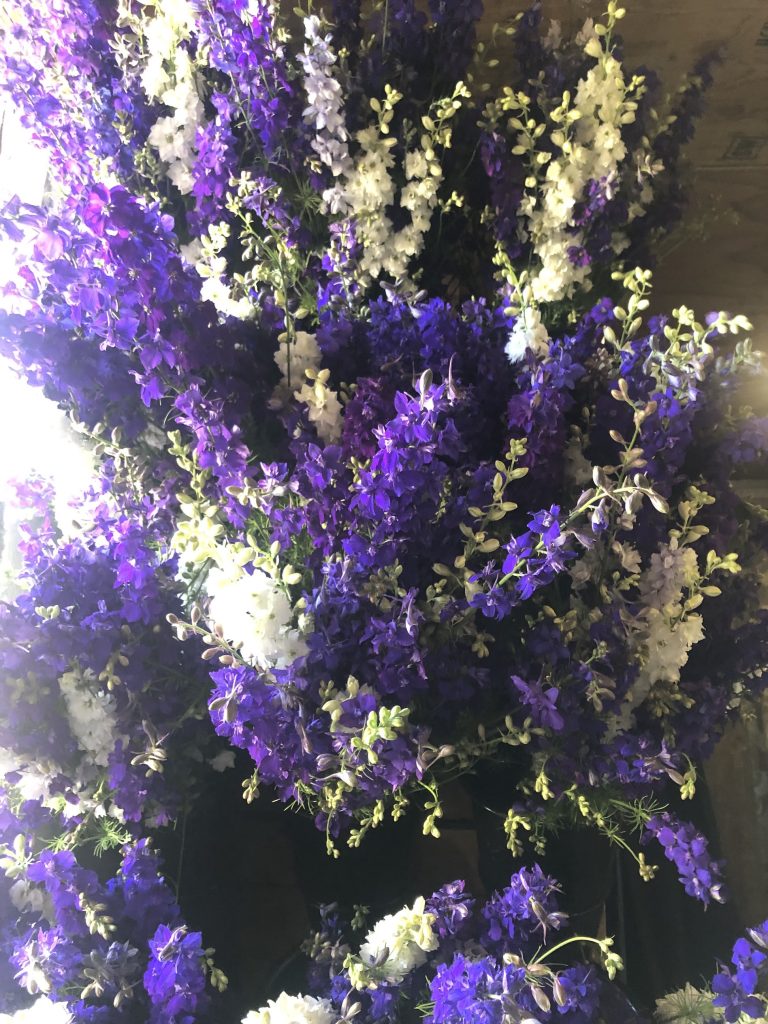
Featured Flower
Larkspur
Delphinium elatum
We overwintered these beauties and it worked like a charm. I seeded them directly into their field bed in the middle of a rainstorm in December, and although they are delicate looking they’re hardy enough to handle a cold, wet winter here. I especially love the dark blue! It’s not a color we see very often in the flower world.
Hidden Villa CSA
Week of June 12th, 2023
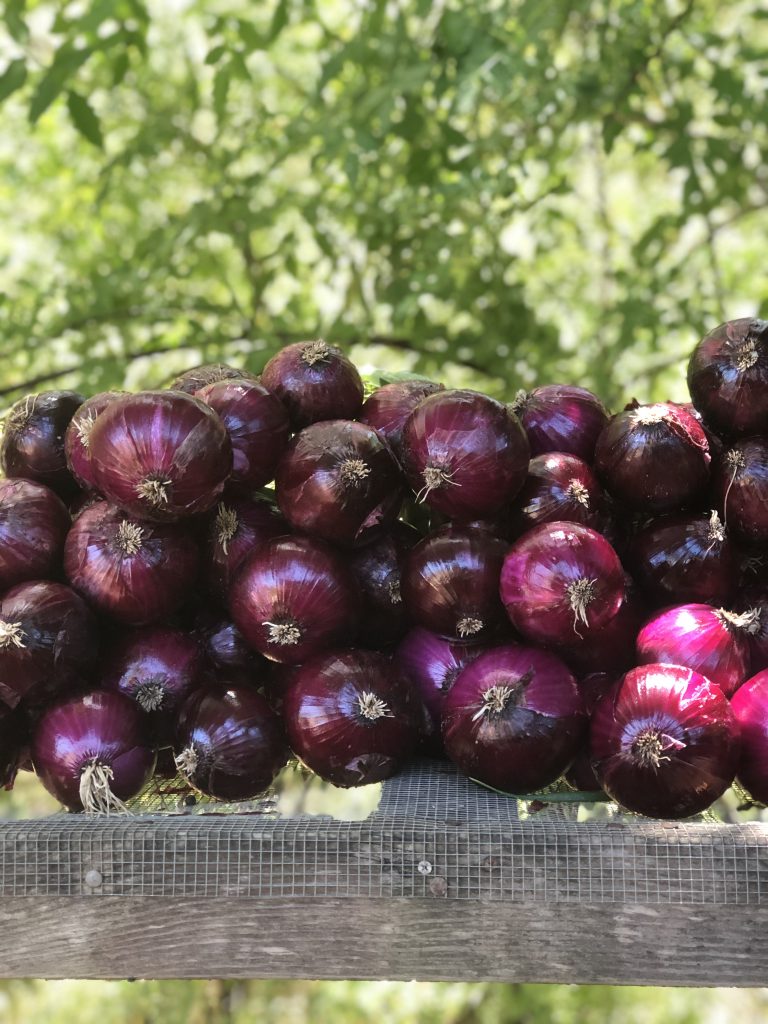
Farm news and events
Hello all, This week the newsletter is light on news and heavy on events. As we mentioned at the beginning of the season, we are hosting a collection of farm based gatherings throughout the summer that we hope you’ll be able to join. Below is the list of upcoming events, more details to follow. Please feel free to reach out if you have any questions.
CSA Events Summer 2023
- Field tour with the farmers, followed by a pot luck lunch – Saturday July 1 tour 10:30-12, lunch at noon
- August movie night – Date and movie to be determined
- Floral design course for flower share members – Saturday August 19th
- Cob Oven Pizza Party – Friday September 8th
- CSA 30th Anniversary Celebration and tomato tasting – Saturday September 30th
And although I’m too pooped to write a proper update, here’s a charming ode to onions that I hope you’ll enjoy. Onions are one of the crops that I think we grow particularly well here and that occupy a special place in my heart. As I’m sure I’ve mentioned before, my paternal grandparents lived in Walla Walla, Washington. While that area may be known for wine today, when I was growing up Walla Walla was synonymous with onions, sweet ones. And I kid you not, my Grandpa Elmer would eat them like an apple. While ours are sweet, I might encourage you to cook them all the same, consider the recipe below…
-Lanette
The Onion, Wislawa Szymborska
The onion, now that’s something else.
Its innards don’t exist.
Nothing but pure onionhood
fills this devout onionist.
Oniony on the inside,
onionesque it appears.
It follows its own daimonion
without our human tears.
Our skin is just a coverup
for the land where none dare go,
an internal inferno,
the anathema of anatomy.
In an onion there’s only onion
from its top to its toe,
onionymous monomania,
unanimous omninudity.
At peace, of a peace,
internally at rest.
Inside it, there’s a smaller one
of undiminished worth.
The second holds a third one
the third contains a fourth.
A centripetal fugue.
Polyphony compressed.
Nature’s rotundest tummy
its greatest success story,
the onion drapes itself in its
own aureoles of glory.
We hold veins, nerves, and fat,
secretions’ secret sections.
Not for us such idiotic
onionoid perfections.
In The Basket…
Red Onions: Sweet spring onions with their bonus of greens are a treat to be sure. Check out the onion based recipe below.
Broccoli: The first of the spring. Not the easiet brassica to grow, so it always feels like a victory to harvest. I love broccoli with cheddar cheese or, though it sounds déclassé, mayo 🙂
Mint: The perfect pick me up for your water or tea on a warm afternoon
Baby Beets: Sugary sweet and tender
Chard: With pasta, potatoes or eggs it’s a delicate nutty green.
Summer Squash: Toss with olive oil and salt then grill. Feels like summer instantly!
Strawberries: No preparation required, enjoy!
French Onion Grilled Cheese Sandwich
- 4 tablespoons unsalted butter
- 1pound onions, peeled, halved and thinly sliced
- salt and black pepper
- 2 teaspoons sherry, red-wine or white-wine vinegar (optional)
- 4 ounces Gruyère cheese, grated
- 4 slices bread, cut no wider than ½-inch thick
In a large skillet over medium-high heat, melt 2 tablespoons butter. Add the onions and season with salt and pepper. Cover and cook, stirring once or twice, until the onions are softened, 3 to 5 minutes. Uncover, reduce the heat to medium-low, and cook, stirring occasionally, until deep golden brown, 20 to 25 minutes. If the onions look dry or like they might burn, add a few tablespoons of water at a time, scraping up any browned bits that are stuck to the bottom of the skillet. If desired, once the onions are done, deglaze the skillet with vinegar and cook until the liquid has evaporated, about 1 minute. Transfer the onions to a medium bowl and season to taste with salt and pepper. Wipe out the skillet, or wash it, if necessary.
Add the cheese to the onions and stir to combine. Put down two slices of bread, and scoop half of the cheese-onion mixture onto each one. Top with the remaining slices of bread, and press down gently.
In the skillet, melt 1 tablespoon butter over medium heat. Add the sandwiches and cook until the bottoms turn golden brown, 3 to 4 minutes, reducing the heat to prevent toast from darkening too quickly, if needed. Add the remaining 1 tablespoon butter, flip the sandwiches, press down and cook until the cheese has fully melted and the bottoms turn golden brown, 3 to 4 minutes. Serve immediately.
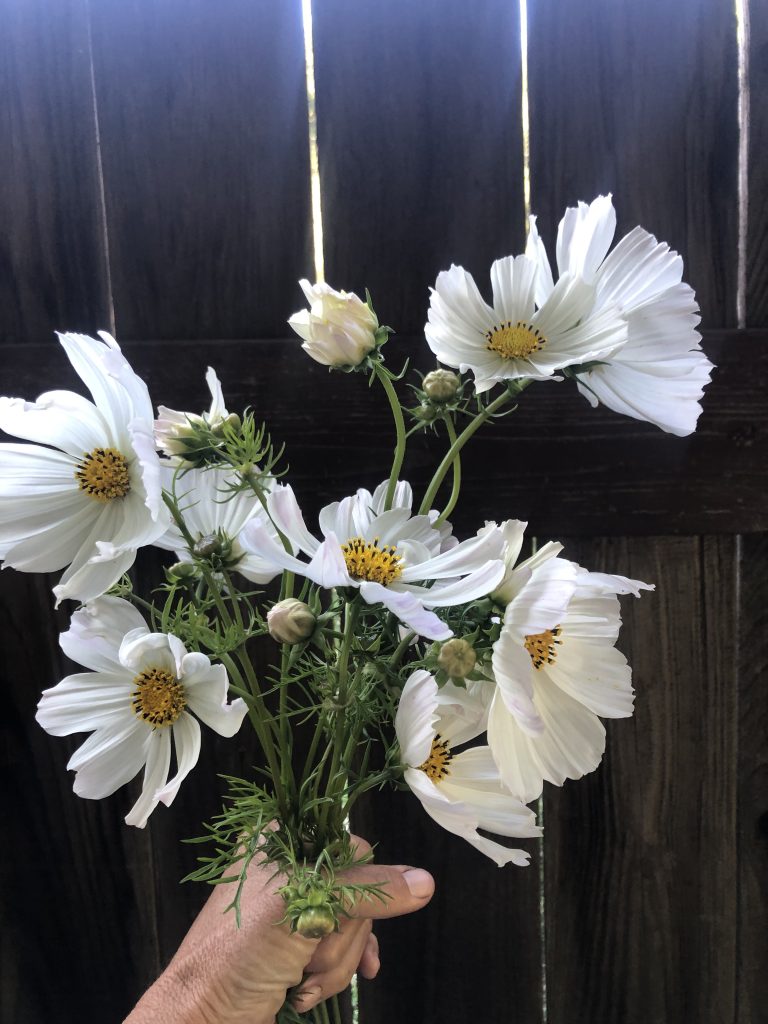
Featured Flower
Cosmos
Cosmos bipinnatus
Another quintinsential spring flower, the cosmo has been a staple for us since day one. They are delicate looking but hardy in the field and last a pretty good long time in a vase. This sparklingly white beauty is called Versailles. Regal, I know. They’re also a favorite of lady bugs and other beneficial insects.
Hidden Villa CSA
Week of June 5th, 2023
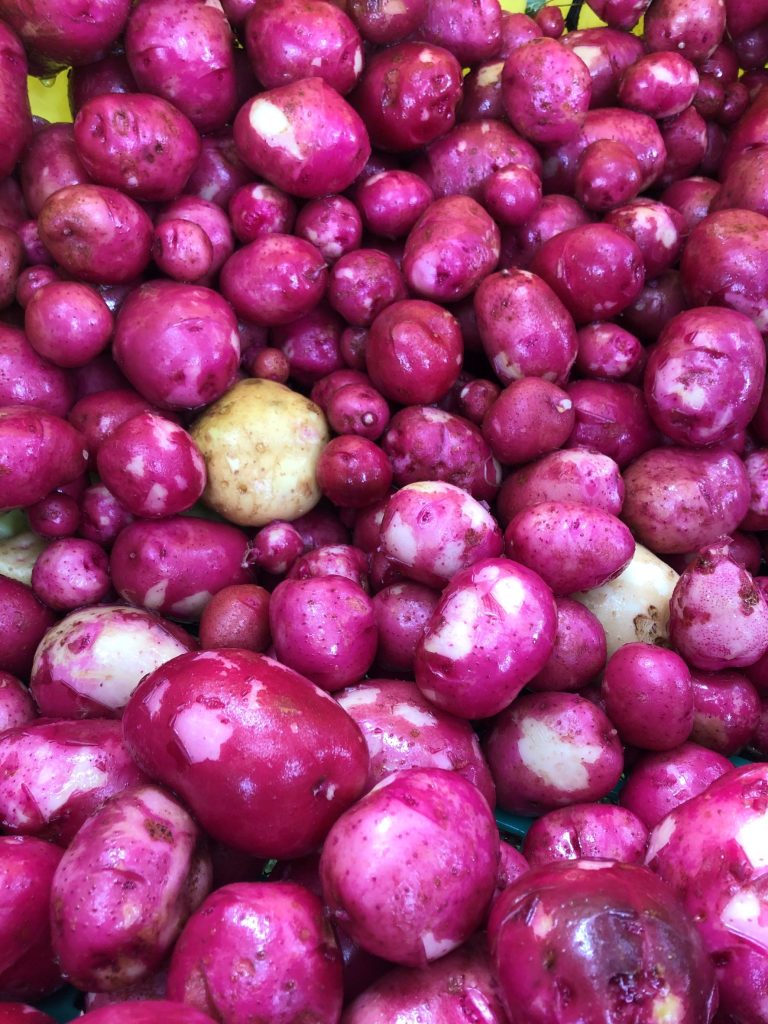
The beginning weeks of any farm season are always kind of nerve wracking and I usually log a lot of poorly slept nights in the months of April and May. It is really easy to get hung up on the failed plantings of springtime and the things that just don’t work out as well as I have planned. For that matter, they rarely work out at all comparably to past seasons.
I had this epiphany in discussion with Lanette recently in which we were commiserating about all of the work we and Katie have put in since March that has come up short. Here it is: For us it is easier to grow things in winter than in spring. On the face of it, this probably seems ridiculous given the increased warmth, sunlight, and soil metabolism in the spring that should afford better overall growing conditions. This doesn’t account for the unbelievably spastic things that happen every spring and only seem to be increasing. Weather variations that punish plants, epidemic infestations of pests of all types, fungal problems, wind stress, flooding, soil crusting, just to name a few.
Part of what informs this observation is that all of the substantial things you have been enjoying in your share box: carrots, chard, onions, garlic, herbs, soon to be potatoes and strawberries were planted in December through early March. Of course winter planting has its obvious challenges in the cold, wet weather that makes for difficult to impossible soil conditions, but these things are more easily surmountable with selective planting timing during periods of easier weather or planting in protected field tunnels. Maybe what I am saying is that I have finally learned that the more predictable and surmountable vagaries of winter are preferable to the crushing defeats of spring.
Take lettuce for example. It stresses me out that we have yet to be able to supply you all with lettuce. I’m embarrassed. We have had multiple crop failures in our spring plantings of lettuce from uncontrollable rodent pressure-armies of voles and squirrels who destroyed over 95% of a full planting to a horribly timed heat spell that cooked the new transplants and then quickly reverted to cold again. In winter we had a modest sized planting of lettuce in one of our field tunnels that grew slowly and steadily, undisturbed by pests, protected from punishing weather. This lettuce was sized and timed to be for the food bank in March. Now faced with the loss of our spring lettuce crops I want to resource ourselves next year to have massive lettuce plantings in more field tunnels done in February so they will be ready for the beginning of our CSA season.
Farmer’s excuses are really boring and you can’t eat them. A big part of me is frustrated with myself that it has taken so long to realize this counterintuitive winter-over-spring idea. I guess it is because of “a higher highs and lower lows thing.” Not everything stinks in the spring but the variances are wider and it becomes easier to evaluate a failed crop in the spring as a punctuated aberrance. I get to thinking “well, that went badly this year but it was ok last year, right?” But when I’m really honest with myself in thinking about years of stressful springs and more quantitatively evaluating them, they are very clearly worse than winters. So that is my choice. I will choose something predictably difficult over something fundamentally unpredictable. Summer is coming and with it will be the steadier and more stable supplies of hearty crops. I can feel it coming with the soon-to-be-here summer squash. Our third succession of lettuce will come on in two or three weeks and I imagine we will stabilize after that. I will keep puzzling and planning to balloon the winter time plantings for next year and give the hectic and harrowing springtime as wide a berth as I can.
In The Basket…
Spring Onions: They are sizing up nicely, great for roasting or grilling and as always the greens are light and delicious
New Potatoes: The first of our potatoes will need to be kept in the fridge in a bag because they have not fully cured their skins yet but this makes them more flavorful! Roast them lightly at 375 for just 15-20 minutes
Rosemary: Minced fresh rosemary is just as good on roasted carrots as it is on roasted potatoes.
Carrots: Sweet and earthy
Curly Kale: The earlier spring kale is better for a massaged kale salad.
Baby Turnips: Tender and sweet little mustard apples, enjoy them sliced into salted rice wine vinegar
Massaged Kale Salad
This salad is an excellent way to enjoy the freshness of the greens with a tangy dressing. The “massaging” has a surprisingly tenderizing effect on the otherwise coarse greens.
- One bunch of kale, destemmed and finely chopped
- olive oil
- salt
- 1/4 cup fresh onion greens
- 3 T balsamic vinegar
- 1/4 t freshly ground black pepper
- 1/2 cup shredded carrots
- 1/4 cup of roasted pistachios whole or chopped
Prepare the kale and put in a large mixing bowl. Add 3 T olive oil and lightly shake 1/4 t salt over the greens. Now roll up your sleeves and really get in there. Massage the kale with force, not pounding or pulverizing, but smooshing the greens in your hands for a solid minute at least. Prepare the dressing by pureeing onion greens, 1/2 t salt, 2 T olive oil, vinegar and black pepper. Shred the carrots. Mix the dressing with the kale and carrots thoroughly. Unlike other salads, this one can be made well in advance of eating and stores well in the fridge for up to three days. A little chilling and co-mingling of the flavors improves them. Sprinkle nuts on top and serve.
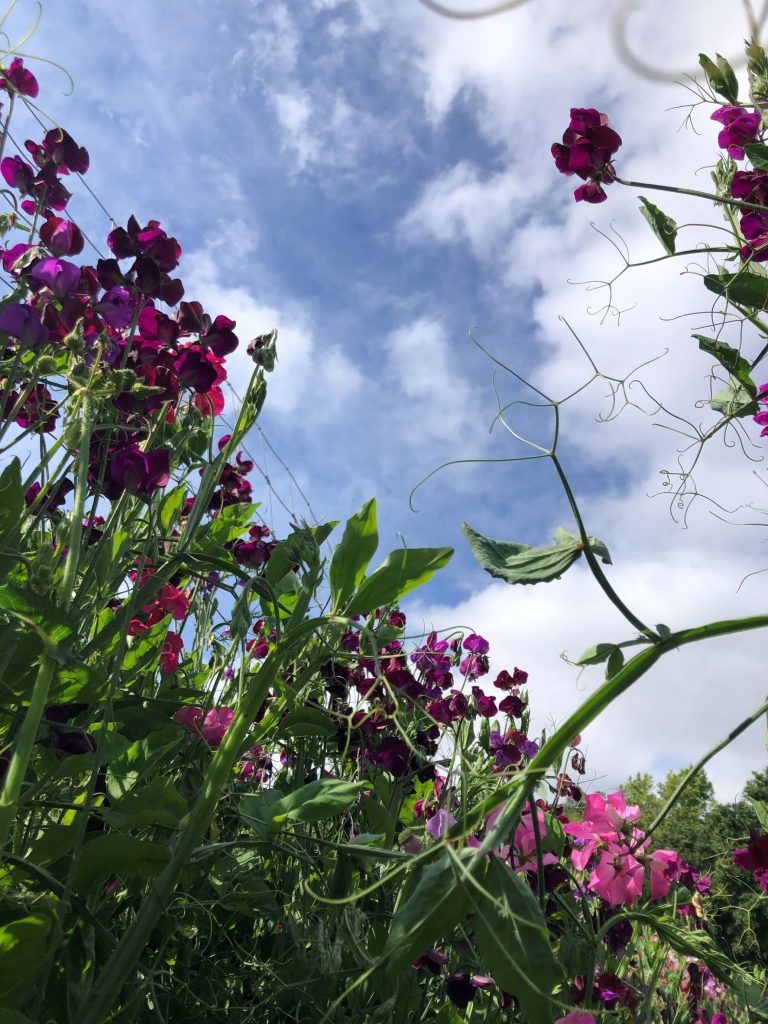
Featured Flower
Sweet Peas
Lathyrus Odoratus
Spring is sweet pea season, it’s also the greens season and rhubarb and radish season, but first and foremost it’s sweet pea season. They are, for me at least, the iconic flower of spring and the scent of May and June. Their relatively brief moment in the sun makes them all the more precious. Their season is short and so is their vase life, compared to all the other flowers we offer but their scent is really what it’s about, and it is divine. I hope you enjoy it as much as I do.
Hidden Villa CSA
Week of May 29th, 2023

Another welcome from me, Katie, one of your farmers here at Hidden Villa! I am currently going into my fifth season at Hidden Villa’s 7-acre organic vegetable, flower and fruit production farm. I now hold the full-time position of Farm Coordinator, and I began here as an intern in 2019 after my first season of farming at Fifth Crow Farm in Pescadero. At Fifth Crow I worked primarily with flowers- seeding, planting, weeding, harvesting, and distributing them to markets, wholesale buyers, and a CSA. Because of Fifth Crow’s scope and for-profit drive, I turned to Hidden Villa, a place that I knew could support me in strengthening a more holistic skill set in all aspects of agriculture. It is at Hidden Villa where I gained a daily familiarity with the variety of methods utilized in regenerative and organic systems- tilling minimally, maintaining water conserving irrigation systems, cover crop and crop rotation practices, compost production, greenhouse management, utilizing organic amendments, and how each of these practices fit into their neighboring ecosystem and our individual and communal health. I’ve had so much space to explore and range my focus from vegetable and fruit production to animal husbandry and environmental education. These hard skills have equipped me with the knack for the trade and the ability to develop a career in an industry just beginning to regain its acknowledged importance. But there is something deeper that guides me to this work…
Considering what Lanette so eloquently described in her previous newsletter, how could I possibly choose anything else but to care for this land that reciprocates my love with such nourishing and abundant gifts? The creek, the hawks, the skinks, the dragonflies, and the weasels all tell the story of a community in balance with nature. If there is anything farming has taught me to celebrate success in, it is when your system reflects the diversity and resilience of its wild neighbors.
I believe growing food organically and with soil regeneration in mind provides any given individual with an opportunity to participate in a system that is often so far removed and commonly detrimental to their community’s health. In my mind, making regional organic food available at grocery stores, farmers markets, or through CSA subscriptions for one’s local community is the most effective way we can incorporate climate action into our daily lives. By utilizing our status as a non-profit that doesn’t need to produce a quantity in the same way that most of our surrounding and coastal farms do, we are able to experiment with our practices, make mistakes, and test out fringe theories that could hopefully serve to inform our for-profit peers of the tactics that may benefit their own land- without taking the risk of experimentation itself. Positioned so perfectly at the entrance to the mecca of the Silicon Valley, Hidden Villa has so much potential to increase the presence and validity of this land regenerating work. Because of you, and all of the supporters of Hidden Villa, we are planting the seeds for a necessary approach to community centered agriculture. Thank you for joining us!
In The Basket…
Arugula: Check out the recipe for a pesto with a kick!
Chard: As Alice Water’s says, add a touch of nutmeg to bring out its best flavors
Radishes: These peppery spring roots are best enjoyed raw or pickled!
Red Spring Onions: Slice these up and let them soak in vinegar & red pepper for a quick pickle enjoyed on your salads and sandwiches!
Carrots: A few more weeks of these glorious roots to come!
Mint: The largest patch of mint I’ve ever seen grown here! Add to yogurt to go alongside meat dishes or make a fun cocktail.
Green Garlic: My favorite thing to do with this spring allium is to chop its greens up finally, mix them with room temperature butter and salt, and smother the mixture entirely over a whole chicken to roast. The stock made from its carcass is a delightful soup addition as well!
Arugula Pesto
- 1 bulb green garlic
- 3 heaped tablespoons shelled walnuts
- 1 bunch of Arugula
- 1 teaspoon salt
- 1/4 cup lemon juice
- 1/2 cup extra virgin olive oil\
- 1/2 cup freshly grated Parmesan
Combine all of the ingredients in a food processor or blender and blend until smooth. If you find that the pesto is too thick to process, add a dash of water as needed. Enjoy on pasta, pizza, or swirled into your focaccia!
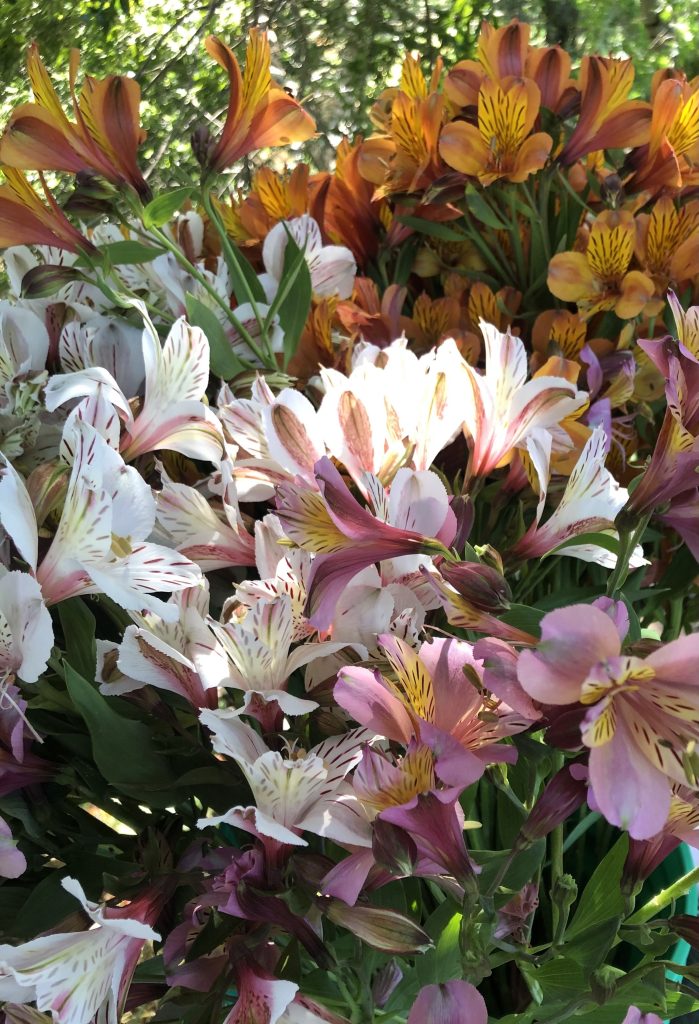
Featured Flower
Alstroemeria
Peruvian Lily or Lily of the Incas
One of our longest lasting flowers in a vase, alstroemeria is both beautiful and hardy. Plus, these little tricksters are another flower that can be propagated from root fragments. We have long grown pinks but the orange, white and red varieties are new to us this year. Since they come in a rainbow of colors and are so well suited to this climate, we might even try to for other shades in the future.
Hidden Villa CSA
Week of May 22nd, 2023
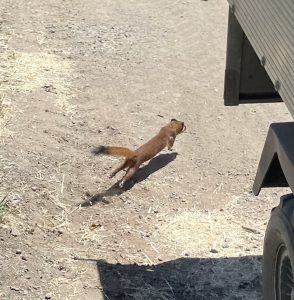
I’d like to join Jason in welcoming you all to the 2023 season of the CSA. As he wrote last week, this year commemorates the 30th season of the Hidden Villa CSA. We’re looking forward to celebrating this milestone with you and sharing in the bounty! And what a bounty it promises to be with all the rain we received over the winter. I don’t want to count my chickens before they hatch, or in this case my potatoes before they’re dug, but a generosity of rain like that can make a farmer a little giddy. We were lucky of course. So many of our farming friends on the coast and in the Sierra foothills struggled with flooding and erosion due to all the wet weather. Although it was a lot here, the most I’ve seen in my 10+ years of farming and living here, our soils soaked it up hungrily with no real damage to speak of. Now, with aquifers full and soil and spirit refreshed we’re looking forward to the abundance ahead.
Encouraged no doubt by the vibrant plant growth, we’ve been seeing a wonderful influx of wildlife in the fields too. Last week alone we spotted a majestic great blue heron hunting gophers in the five acre, she caught at least two that we saw. I came across a pencil thin ring-necked snake sleeping in the dirt. Katie saw a playful little weasel darting around by the apricot trees (picture above), and I watched a red-shouldered hawk snatch a vole from the green growth by the creek. Working outside is high on the list of reasons why I love this job. Getting to witness wildness around me goes beyond fringe benefit. (A phrase by the way that until fairly recently I thought was ‘french benefit’, which also sounds like something nice.) It’s an enlivening and moving experience, a communion of sorts. We can be pushing through a harvest, stressed by the heat and the rush, but at the sight of a hawk soaring overhead we all slow, eyes lifted in reverence.
Not all creatures are equally welcome in the fields of course, at least not by me. The lowly pocket gopher whose tenacity and earth moving abilities I respect, is a major pest for us. So, trapping gophers is a necessity on the farm. Or the crows, whose combination of intelligence and curiosity, looks suspiciously like mischief when they pull out newly planted starts or gang up to chase away the birds of prey. It may not be reverence that I feel for them but there is respect to be sure and an awareness that they have a place in this ecosystem too.
The farming methods we practice invite the wildness in. In these fields they can eat a gopher or vole, of which there seem to be an uncountable many, without fear of pesticide poisoning. Those hawks and snakes are part of the farming plan. We rely on them as partners in pest management but perhaps more significantly, their presence is a reassuring indication that we are succeeding in one of our main goals: to tend the land with respect for its many inhabitants and care for the farm as the agro-ecosystem that it is.
-Lanette
In The Basket…
Mizuna: Like arugula, mizuna is a mildly-spicy spring salad green. I recommend tossing it with a sweet dressing and maybe some grated carrots.
Spinach: I was not a spinach fan as kid, but I bet if I’d been eating these nutty leaves I might have felt differently.
Rhubarb: Time for a tart?
Walla Walla Spring Onions: These are really a two-for-one deal. Both the bulb and the greens are a treat. I recommend blending (in your blender) the greens with olive oil, balsamic vinegar, salt and maybe a dollop of jam for an unbelievably creamy salad dressing.
Carrots: Perfect raw, roasted or pickled. See this week’s recipe.
Oregano: Chop up a few tablespoons of fresh oregano and add it to a pot of beans in the last fifteen minutes or so of cooking or when you warm them up. Such a delicious pairing.
Lacinato Kale: Spring kale is the most tender of the whole year. It only needs a light sauté to cook. Or if you’re a soup lover like myself, the kale, oregano, carrots and onions are the start to a delicious minestrone.
Spicy Pickled Carrots
- 4 large carrots sliced on an angle
- 1-2 jalapenos (out of season I know)
- 2-5 cloves of garlic, depending on your preference
- 1 cup white vinegar
- 1 cup water
- 2 TBSP sugar
- 2 tsp salt
Bring a pot of water to a boil to sterilize pint sized canning jars and lids. Meanwhile slice carrots and jalapenos, chop garlic.
On low-medium heat bring the vinegar, water, sugar and salt to a boil.
When your jars are sterile (leave water boiling) pull them out and arrnage carrots, jalapenos and garlic tightly into the jars. When the vinegar solution has boiled, turn off heat and pour the liquid over the carrots, filling the jar to about 1/4″ from the top. Place the sterile lid on and twist to seal, but not too tightly.
Hot water bath boil for 8-10 minutes. Store the jars for at least 3 weeks before eating. Enjoy!
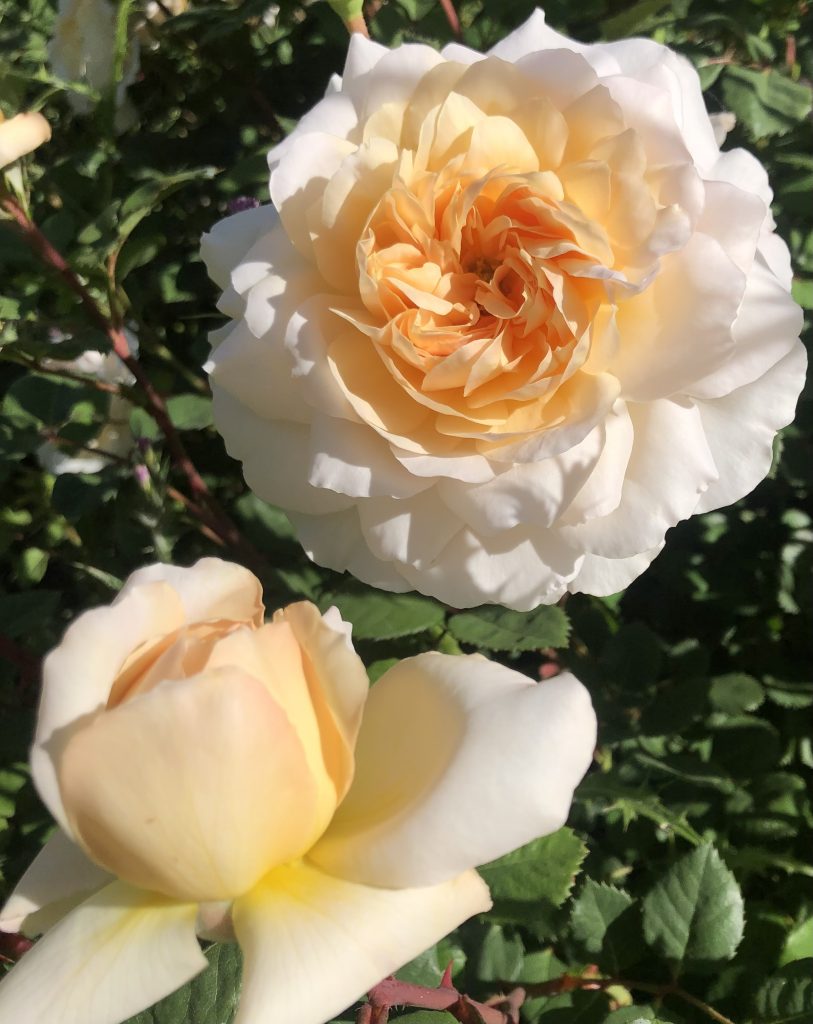
Featured Flower
English Shrub Rose
Rosa ‘Crocus Rose’
I resisted growing roses for a long time. I didn’t want to bother with the thorns, the yearly pruning and feeding. I thought of them as too precious and maybe a little bit uppity. In the end I was won over, really it was inevitable, how could anyone not be. Their beauty and perfume are so seductive. Specifically, it was the roses from the English breeder David Austin who focused on scent and big, full-bodied blooms in a rainbow of subtle shades. These flowers have a good ‘face feel’ as our dear friend and HV alumni, Niki Gribi, would say. I hope you enjoy!
Hidden Villa CSA
Week of May 15th, 2023
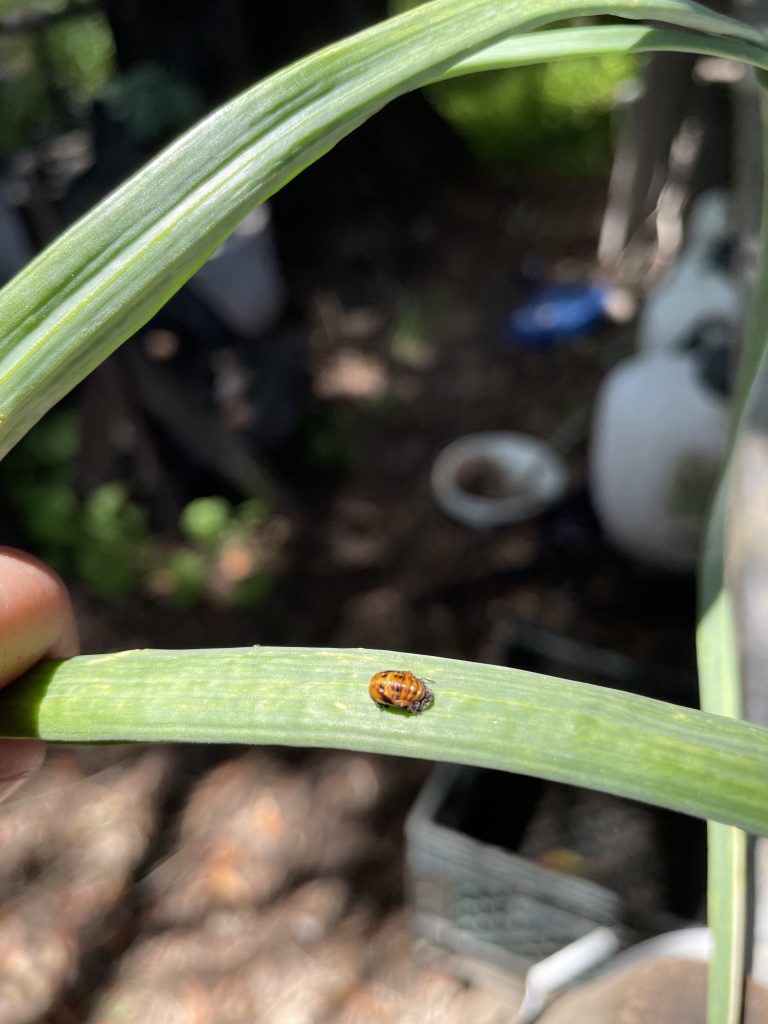
Welcome to your 2023 Hidden Villa Community Supported Agriculture season! My name is Jason McKenney and I am Hidden Villa’s Agriculture and Facilities Director. Together with Lanette Anderson, Katie Huddleston, and Sophie Simpson we grow and operate our program of providing seasonal, weekly produce and flowers to our subscribers.
Thanks to Lanette for having the idea and for writing monthly winter newsletters. Please do let us know if these efforts helped to keep you in better touch with the farm. As with most Californians the heart of the farm story this winter was water. At Hidden Villa, provided the rains have ended, we have had 42 inches of rain this winter and spring! This is our wettest year on record. The soils on the farm did a spectacular job absorbing and infiltrating all of this precious water as did our forested areas. We are taking it as positive feedback on our stewardship that our land could stand strong through such a battering array of storms as this winter brought and emerge into a verdant spring with very little erosion, mudslides, downed trees, or creek scours. As you might imagine all this rainfall did slow down our efforts at winter preparations and planting and you will see this reflected in some later crop timing and very greens-heavy initial weeks of the basket.
This spring we also carried out a massive amount of fire mitigation work. Our property manager, Lukas Wiborg, in partnership with a team of Sierra foothills based wildland firefighters who call themselves Deer Creek Resources, safeguarded the highest priority areas of Hidden Villa through select vegetation removal and localized chipping. If you have not been out to Hidden Villa this year I strongly encourage you to come and see the transformation that this work has made. It is our hope that this first phase of three of fire mitigation work will serve as an educational template for visiting public and neighbors to see and understand what preventive, ecologically sound fire management practice looks like.
This winter I was able to outfit and begin to operate our compost turner more efficiently. This is a piece of heavy machinery that we bought last year to assist in the speed and quality of our compost making on ranch but I found that our tractor was clunky in operating it. After making some modifications to the hydraulic system on our larger tractor I was able to start really using this piece of equipment in earnest. I also did some much needed repairs and updates to our 75 year old manure spreader which is the piece of equipment that we use for spreading finished compost onto our fields. These upgrades have already translated into us having spread 27 tons of beautiful compost onto our freshly worked soils. I know that with this equipment online we will transform what had been a dirty and super hard job into a joy that will result in a faster recycling of organic wastes into soil enriching compost.
This year is the 30th anniversary of Hidden Villa’s Community Supported Agriculture program. Stay tuned for more information about how we intend to recognize and celebrate this milestone. Thank you for joining us for our season. We look forward to connecting with you.
-Jason
In The Basket…
Lady Bug Pupae: I am kind of joking putting this here but among the positive ecological signs we are seeing this year is an unprecedented amount of ladybugs throughout the farm. At an early life stage the soon-to-be beetles undergo a metamorphosis that involves them attaching their pupae (cocoons) to leaves until the adult beetles emerge. We harvested so many of the things in this week’s share basket with inhabited pupae on the leaves. If you find anything that looks like the enclosed picture on your produce or flowers please relocate them to your garden or lawn. They will spread the love in the form of emerging into voracious beneficial predators of multiple pests!
Bok Choy: These early spring greens are tender and tangy despite the emerging flowers on many of them. Perfect for all kinds of stir frys and soups. See recipe below.
Arugula: The first salad greens of the season are young and light arugula. Dress lightly in a salad or use on sandwiches. Even goes great coarsely chopped into a cold pasta or quinoa salad.
Mint: Hidden Villa’s unique and nameless mint is a wonderful addition to yogurt sauces, tabouli, or salad dressings or makes the best mojito you have ever had!
Carrots: Planted again this year in the first week of January in our caterpillar tunnel-the marvel of overwintered carrots. Great for fresh eating, in salads, stir frys, soups, you name it. You can expect to have carrots in at least the first five baskets.
Rainbow Chard: Colorful and rich cooking greens that make awesome enchiladas and sandwiches. Try adding them to a soup or making a slaw out of just the finely minced stems-the color is incredible that way.
Green Garlic: Immature, unbulbed garlic is known as green garlic and has the advantage of the whole stem and leaves being delicious, mild, and more subtly flavored garlic. A little of the greens pureed with olive oil, salt, and balsamic vinegar makes what is still my all-time favorite salad dressing.
Radishes: Slightly spicy and perky gems for adding to salads, fresh pickling (chopping into a tupperware with rice wine vinegar and salt overnight in the fridge) or roasting the whole vegetable greens, roots and all by tossing them in olive oil and salt and roasting in a 400 degree oven for 12-15 minutes.
Mu Shu Vegetables
- 5-7 medium carrots sliced into thin, small sticks
- 3-5 chard leaves coarsely chopped
- 1 head of Bok Choy coarsely chopped
- 1 full green garlic coarsely chop the greens and upper stalk, very finely mince the bulb and white parts
- 3 T Hoisin sauce
- 1 T olive oil
- 1 T soy sauce or tamari
- 1 t toasted sesame oil
- 1 T rice wine vinegar
- 1/4 t red pepper flakes (if you desire the spice)
- 4 eggs
- white rice or flour tortillas whichever you prefer
Put on a saucepan of rice if that is your preference. Prepare the vegetables. Make the sauce by combining in a blender garlic greens, hoisin, olive oil, soy sauce, sesame oil, rice vinegar, red pepper and 1/4 cup of water and pureeing. Salt to taste. Preheat a large skillet or wok over high heat. Beat the eggs in a bowl. Add a teaspoon of olive oil to the wok quickly followed by the white garlic. Lightly salt it as it is sizzling. Stir it constantly for 30-40 seconds until it is lightly browned and then quickly add the beaten eggs. Continue stirring the egg mixture in the hot wok until the eggs are fully cooked-no more than 90 seconds. Remove the eggs to another bowl but leave the wok heating. Now add another teaspoon of olive oil to the wok and add the carrots. Stir fry the carrots for 5-6 minutes until lightly golden. Add the chard. Stir fry the carrots and chard another 4-5 minutes until somewhat tender. Add the bok choy. Stir fry for no more than 2 minutes before adding the sauce. Continue stirring the mixture until the sauce has thoroughly coated the vegetables and then add the egg. Turn off the heat. Serve immediately over rice or wrapped in tortillas.
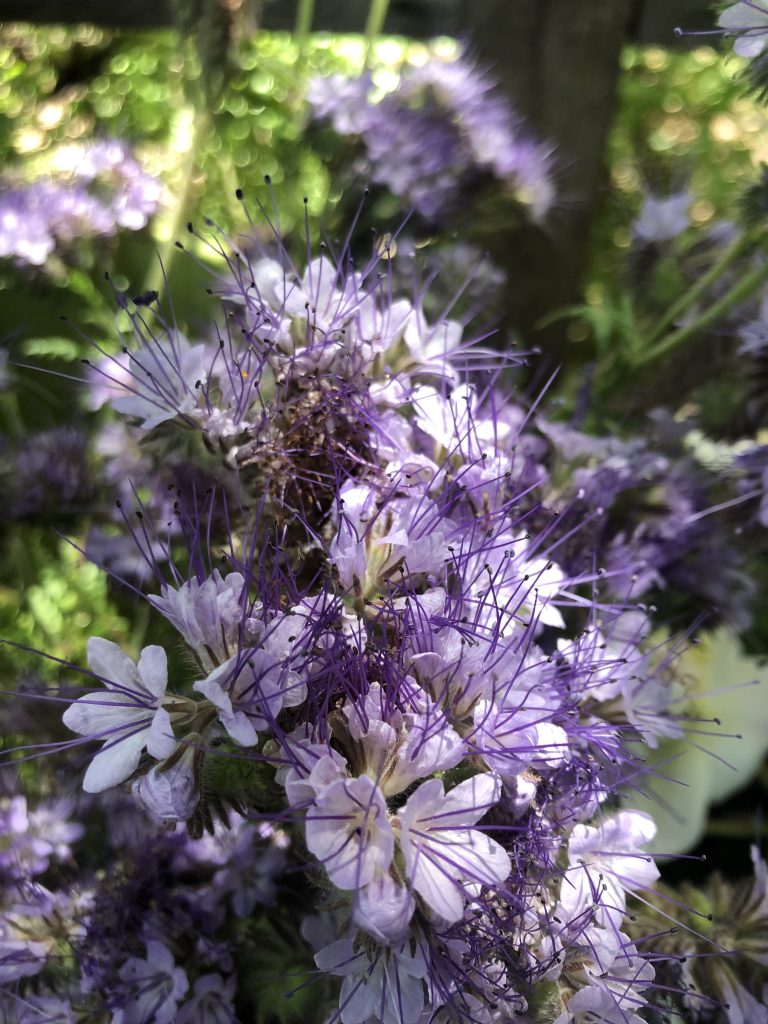
Featured Flower
Bee’s Friend
Phacelia tanacetifolia
For newer members, this section of the newsletter introduces you to some of the various flowers we grow. We pride ourselves on bringing you beautiful and unique blooms that you won’t find anywhere else. In this section we’ll tell you a little more about them , a new one each week. Enjoy!
Bee’s friend is now a spring staple for us. I love their lacey, bluish-purple blooms, their unique fiddleneck shape and how wonderfully quickly they grow from little shoots into long-legged plants. Oh, and of course how they seem to attract bees from miles around!



